#that's an interesting one. generally very impressive especially on a visual level. interesting consequences for navigation etc.
Explore tagged Tumblr posts
Text
to clarify on what i'm saying about the VA feeling awkward here - I'm sure when it comes to a big emotional scene they're going to nail it, the actual VA itself here is generally really solid. it's more about inevitable technical issues to do with how dialogue is implemented in a game like this - not new issues, they're the same issues that just about every Bioware game had.
I actually have in mind a really old post that @expertpedestrian once made, which sums it up very amusingly:
What I’ve been hoping is that DAI was phase one of the Great Bioware Technology Update, with them having to get to grips with a whole new engine; phase two could then be them updating all the little things, like their animation and conversation systems. The flaws in their dialogue pacing are particularly noticeable when one character interrupts another: ANXIOUS SERF: Inquisitor, it is absolutely vital that I– [just under one second of total silence] IMPERIOUS TWIT: Begone, peasant! The Inquisitor and I have much to– [just under one second of total silence] RAMBUNCTIOUS LAYABOUT: Will both of you stop yelling?! I’m trying to get some– [just under one second of total silence] [then the table explodes]
(yeah. i used to have a dragon age blog. i knowwwwww)
bg3 is generally not as awkward with it as Bioware games tended to be with the awkward pauses between lines, but it does occasionally have a similar sense of disjointedness. I would say the reasons for this are...
in just about every game, the voice acting must be chopped up into lines; in a Bioware-like CRPG, each line in the script will be associated with an appropriate emote animation which is then blended procedurally with other aspects of animation like gaze, blinking, general idle fidgeting etc.
if subsequent lines were recorded at different times, which they must be since this is a dialogue tree system with multiple paths, there might be a noticeable difference in the line read/intonation. this doesn't happen too often, but it is noticeable at times.
the game must write around the blank-slate CRPG main character, whose insertions into the dialogue tree are necessarily fairly generic, and in this case, unvoiced. a character can turn in a fraction of a second from aggressive to fearful because your character said something intimidating, but because the actual intimidating line is not reinforced by voice acting and animation, it leads to a jarring transition. (this is admittedly perhaps a downstream effect of overfamiliarity with the Bioware/Telltale model where the protagonist is fully voiced, and doesn't always say what you think they're going to say, which is a different set of problems.)
sometimes it's a writing issue - the NPC's reply seems to be repurposed from another part of the conversation tree and not quite fit what your character said.
the limitations of the animations and rigs. if the capacity for subtle facial expressions is limited, then acting must be quite broad. but we're at 'see the pores' closeup levels most of the time here. it's an odd sort of uncanny because the characters are generally quite alive - they blink, look to and fro, fidget etc. - but the animations seem kinda unmotivated on a physical 'acting' level, since it's still fundamentally just canned animations, there is physically no way that they could animate every cutscene.
to be clear this is the kind of thing that emerges because other aspects of the character rendering are so advanced. I feel like lower-detail or more stylised models can 'get away with' more.
the real issue is that rendering has advanced a lot faster than procedural animation in videogames. we understand the physics of light very well - which isn't to say that writing a well-optimised efficient shader for skin and hair and the like is easy, but it's a fairly bounded problem.
animation is another story. while we have all sorts of sophisticated techniques now - many kinds of IK, inertial blending, motion matching etc. - you're always dealing with all sorts of weird edge cases. animation is also potentially quite expensive, both in terms of rendering (the more complex logic you have to do, the more milliseconds the CPU isn't doing other things; the more detailed your animations, the more disk space they demand and the more data must be streamed into memory and unloaded afterwards) and in terms of time to author it (animations take a long time to make, and while you can use mocap to get to more natural performances more quickly, cleaning up mocap data and blending it plausibly is also time consuming). creating a good IK system is more of an art than a science - lots of tuning different parameters and solvers until it gets the results you like.
and while Naughty Dog and their ilk will go out and prove we can get very impressively natural looking animations in games now, it's way out of the reach of most studios, even with D&D money. the animations in BG3 don't look bad exactly, they're just... not on the level of the rendering, in a way that's noticeable. if you tried to shoot a movie like this, it would be a very strange and awkward movie. but then movies don't have to be hundreds of hours long!!
perhaps some relevant context is that I'm right now working on animation for our game - nothing anywhere near as complex as what BG3 is doing, but then we're not nearly so big a studio lol, and I'm trying to make something way better than it should be by dint of pure hyperfocus - so. perhaps I am particularly alert to animation jank right now.
I should say that even if I observe places BG3 is flawed, none of this is trying to say 'it's a bad game because bla bla bla'. it's more a record of encountering this artefact of the whole like, cultural machinery that produced it - the D&D revival, oldschool CRPG nostalgia, newschool CRPG-with-sex-in-it, the general evolution of the Bioware-like game, and in general observing what's easy and what's still difficult in even big budget videogames nowadays.
identifying the flaws in a thing helps me decide what I wanna do differently if I ever get the chance to work on an RPG lmao. (which would honestly be amazing, I really wanna make an RPG, I love games with a big emotional story most of all and those tend to be RPGs. hell an RPG might actually make sense in VR if the vision pro is as comfortable to use for a long period as they say. or maybe I'll end up working on flatscreen games at some point down the line.)
anyway. it's a bad game because it isn't disco elysium
more baldur gate
I think I've gathered most of the party now. time to venture forth
we did find another warlock it turned out. they've got a spin on him as a kind of demon slaying folk hero, which is cute. what's weirder to me is when characters will just casually speak of game mechanical stuff like being a 'warlock'. like, oh yeah i made a pact with an eldritch entity beyond space and comprehension, but it's no biggie, you know? there's one in every neighbourhood. though that is something of the problem of Forgotten Realms, it's such a kitchen-sink setting that it's very hard to figure out any sort of coherent narrative thrust for any of it.
my character seems to be settling by default into the kind of default 'pragmatic, generally prosocial crpg hero' model. most of the other dialogue options just seem needlessly standoffish. they do have certain party members disapprove when you take plot hooks, but honestly that all feels a bit silly to take as a prodding to play a more selfish character because like. what do you want me to do, not engage with the game? occasionally you get to click a 'hey, look, I'm also from baldur's gate!' dialogue option, but it never adds up to much.
it's frustrating in a way, because this being so specifically D&D-based really calls attention to the difference between CRPGs and TTRPGs. at the tabletop, I can give my character a distinctive voice, motivation, general habitas - and other players can respond to that and react appropriately. of course, this is not possible in a CRPG to the same degree, except within the rails laid down by the game writers. since the main character is unvoiced and characters react to dialogue the instant you click it, she is even further diminished from the voiced characters.
something noticeable in this is that it has a similar line reading problem as a lot of Bioware RPGs. characters' lines will sometimes noticeably differ in how they're acted - intonation, force, etc. - and there's that ever-noticeable cut between individual lines of dialogue. it has the feeling that the lines were recorded separately in a studio without much in the way of context.
overall the NPC acting in this game is... well it's that classic modern AAA videogame problem right? the character models and rendering are very lifelike when they're still, but the way the characters move is a bit stiff, a bit broad, a bit unnatural. of course nobody has the money to individually hand-animate every single dialogue line in a CRPG of this sort of scale, so they're leaning on canned animations and procedural blending techniques, and it works sorta well enough. it's got that fuzz of videogame jank to it.
it looks like we're about to run into the Evil Races D&D Problem pretty soon, oh boy! the goblins are attacking the poor tiefling refugees. why? i'm sure it will be given a clear understandable motivation and not just that they're evil by nature, right? this is something that I'm pretty sure the game is inheriting from the OG Baldur's Gate games - I definitely remember venturing into a mine to fight gnolls or something. Minsc was there. I have no doubt Minsc will show up in BG3 as well - he's like the most iconic character in the series.
the contrived nature of the premise is classic D&D shit. "you all meet on a mind flayer spaceship, united by parasites in your brain" is definitely the sort of thing that a human DM would cook up as a campaign starting point. that said, it does feel a little weird that everyone on the mind flayer ship between them cover most of the player classes, each with their own colourful backstory and an identically sized tent that they can pitch in your mysterious extradimensional campsite. I think the fact that the introductions are spread out a bit makes it feel more artificial - I get why they didn't want to frontload it with every single character right at the beginning, but it's like, 'damn, this guy has a player character sort of vibe, i bet he was on the airship' and sure enough, he was...
(speaking of the immersion-breaking camp, the respec guy really seems kinda unnecessary as a diegetic element. just have a menu somewhere, trying to make this skeleton guy make narrative sense just raises way too many questions.)
but I mean I can't complain too much that a videogame is a videogame, right? as I recall, in BG1, the recruitable party members were just random adventurers who you'd run into here and there. this is more of a KotOR II-like scenario, where every character has a thing in common that pushes them together.
the Tactician difficulty level, combined with the squishiness of level 2 characters, is definitely pushing me a bit. I had a fight with some bandits. all of them had names and unique voices, interestingly - really applying the Apocalypse World principles. however they will not like, surrender or anything. don't ask me why I was fighting these people to the death, I don't think they did anything that really did any harm to my character, but I wanted to unlock the respec character and you have to get past them to do it. not that I knew that when I saw hostile characters.
anyway, it was a cool fight because it was a bit of party-vs-party - the enemies were using the same abilities I was, and using the environment to their advantage (read: blowing me up with exploding barrels, the nerve of it). Larian of course have their fancy fluid sim system from the Divinity series, which actually integrates rather well with certain D&D spells like Grease. there's a lot of potentially interesting tactical possibilities, although in the end, it came down to the familiar tactics of 'split them up', 'disable them with debuffs' and 'focus dps'. D&D combat is very swingy - once I took out a couple of that other party, the fight was pretty much decided, but when I'd taken a few downed party members, there wasn't really much reason not to just load the quicksave.
I decided to spec my 'lock as a bladelock - I'm playing a chainlock on tabletop so this seemed like a good way to mix it up. of course then it turned out that Wyll is also a bladelock, so he's probably not gonna get much time in the party ^^' but maybe I should bring him along and we can just be warlock buddies. that said... the 4-person party size is... I can see its necessity as a balancing measure, but it does feel like it pushes me towards the standard healer (shadowheart)/tank (lae'zel)/rogue (astarion)/me structure. since I need someone to unlock doors, I need someone to heal, and I need someone to stop the enemy beating up my poor squishy party members. but now I'm a bladelock, maybe I can take over from Lae'zel as the frontliner and free up a slot for one of the other guys. probably it's a big enough game that there will be room to mix and match parties over the course of it.
one thing I do kinda miss from Bioware's games is the intra-party dialogue triggers. the characters here mostly don't have random conversations, at least so far - maybe they will later in the game. that stuff did a whole lot to add life to your party members and make them feel more like characters.
honestly? this is making me want to go back to various isometric CRPGs like Tyranny. so far, despite spicy elements like the mindflayer thing, I'm not fully hooked by this story. but I will give this one a chance all the same.
#computer games#baldur's gate 3#i haven't even talked about the environment design yet#that's an interesting one. generally very impressive especially on a visual level. interesting consequences for navigation etc.
19 notes
·
View notes
Text
HOW THE ANIMATION SERIES ‘POWERPUFF GIRLS’ AND ‘MY LITTLE PONY’ BUILD STEREOTYPES ABOUT GENDER AND SOCIAL BEHAVIOUR THROUGH CERTAIN CHARACTERS?
ABSTRACT
The topic of this essay is related to animation - art as ancient as it is modern. Despite a step up aside from standard graphic design, animation deserves properly attention as the only art that unites everyone else: drawing (illustration), acting (movement), music and narrative, and this makes it so appealing field for visual expression.
The subject of this study will be the wonderful world of the creative family of Craig McCracken and Lauren Faust and this choice is not accidental. He is a consequence of long-term interest (initially as a fan, and now professionally) in the animations created by them.
This study will seek to reinforce the stereotype that in the late 20th and early 21st century women are independent , strong enough and able to cope with life's challenges on their own, which is embedded in 'Powerpuff Girls' (animated series created in 1998 by Craig McCracken), as well as the stereotype that behaviour is not a function of gender and in this sense there are no 'good' or 'bad' genders. There are those who act socially acceptable and those who do not, which is reflected in both animated series : 'Powerpuff Girls' and 'My Little Pony : The Friendship is magic"(created in 2010 by Lauren Faust.)
The influence that these series cause as well as their reflection in social life and in some manifestations of the subculture will also be affected.
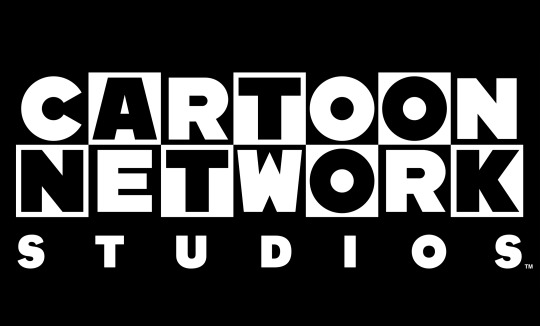
This essay will offer an overview of some gender and behavioural specifics of the characters from animated series ‘Powerpuff Girls“’ (1998) and ‘My Little Pony : Friendship Is Magic’ (2010). This matter will be explored using various descriptive and comparative methods and knowledge of semiotic analysis obtained in previous levels of education, as well as with the help of well-studied existing literature on gender stereotypes and human behaviour and their reflection in a modern animation for children.
● The composition (environment) as a surrounding background in the two animated series will be analyzed and compared. Will be answered how and to what extent it can influence the actions of the characters which reflect certain social and gender stereotypes.
● Concepts such as Second and Third Wave Feminism will be addressed and an analogy will be made between feminism and the heroines of the Powerpuff Girls series.
● A review of the actions of the characters from the above-mentioned animated series will be made, and the link between existing concepts of the role of gender and social behaviour in society will be sought. The perception that the imposed gender stereotypes should generate certain perceptions, questioning their appropriateness will be challenged (and this will protect the rights of certain societies and groups such as the Queer society, for example.) The essay will stand behind the thesis that behavior is not a function of gender, considering the behaviour of a particular character with an unidentified gender identity from "Powerpuff Girls".
● Existing gender stereotypes will also be compared and challenged with some alternative ways that determine the place of gender identity in human society. Will be answered of the question why animation designed for a little girls, such as "My Little Pony", affects a certain group of people (young men called "Bronies") and how they interpret the gender stereotype (or lack thereof), creating and developing a certain modern subculture, such as the Bronylore sites, for example.
The choice of this topic is due to the fact that in the process of studying I was very impressed by the tasks related to video making and the animations that I used in performing these tasks. In addition, the topic expresses my desire to continue to engage in animation as a practitioner in a future, and if this happens, all of the above issues regarding gender and behavioural stereotypes would be useful in creating credible animated characters.
All cartoon characters have their own story, and even if the interactions between them seem to "make" the film, the fact that the characters are always in touch with the world around them should not be overlooked. They are part of it, they see it, they touch it, they move and meet other peers in it and all this pushes the action forward. This surrounding world and its story creates the composition of the animated series, and it depends on it whether the action will increase or decrease when one of the characters is placed in it. Therefore, here will be considered some characteristics of the composition and their manifestation in the two considered animated series ‘Powerpuff Girls and ‘My Little Pony : The Friendship is Magic”.
The layout of the composition in the animated films is a special type of design, which is created by layout artists and background painters.
Both the exterior and the interior composition in 'Powerpuff Girls' and 'My Little Pony: The Friendship is Magic' are used as a background for the actions of the characters in building social and gender stereotypes. Let's see how this works.
The exterior images of Townsville in the 'Powerpuff Girls' series appeared as a result of the interaction between the bourgeois aesthetics of post-war America in contact with the more popular taste of the 1950s. They show a love of urban architecture and its details (especially the Precision style, which later grew into American modernism and the UPA house style - the dominant style in animation in the 50s and 60s.) The three little heroines act in this urban environment, by demonstrating their superpowers and protecting the city from evil monsters and invaders, which reinforces the stereotype for the belief in traditional values.
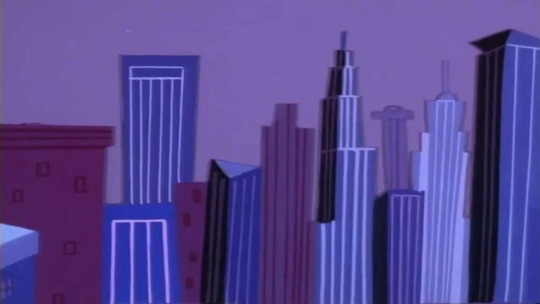
Fig.1. The City of Townsville (Source : Fandom.com)
In contrast to Townsville's modern urban environment, Ponyville's exterior view from 'My Little Pony' expresses the idea of living in a natural environment. Ponyville's infrastructure is presented as medieval architecture in a country style, recalling the fact that the Middle Ages were the period in which most magical spells were performed. The typical cottages have a wooden frames and thatched roofs overhanging the upper floors. There are all kinds of buildings here, just like in the human commune: train station, clock tower, hospital, day spa, joke shop, Hay cafe, Golden Oak library, theater, even school (which challenges one of the possible existing stereotypes who claims that this animated series presents the girl's brilliance and beauty as more necessary than knowledge and learning.)
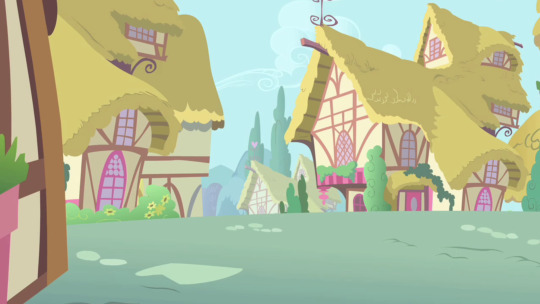
Fig.2. Ponyville
(Source : Fandom.com)
As can be seen from the design of the three girls' bedroom, it is built almost entirely in pink and pale purple (except for the blankets, colored with the characteristic individual colour of each one of them), which is associated with the female sex, according to the existing modern social stereotype.
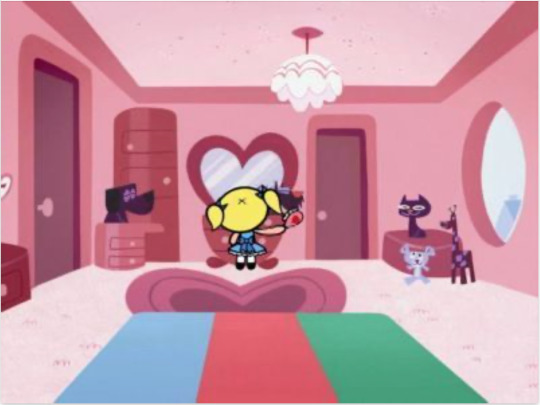
Fig.3. The bedroom of Powerpuff Girls
(Source : Weheartit)
This certain ‘girlish colours' trend in the interior composition of bedroom continued a decade later in "My Little Pony: Friendship Is Magic" and this once again confirm this stereotype: pink and pale purple are just girlish colours (and therefore unacceptable for boys.)
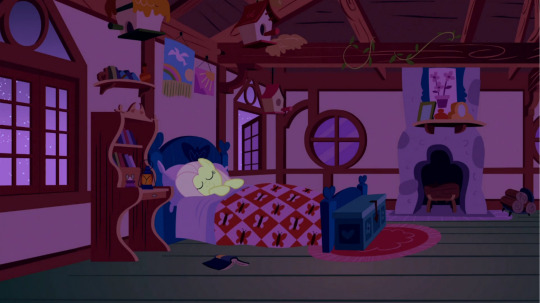
Fig.4. Fluttershy's bedroom
(Source : derpibooru.org)
This naturally raises the question: do not such restrictions impose from an early age a reluctance to see the other point of view, that of the opposite sex? Or it is deliberately ignored? Isn't part of the natural emotion of childhood taken away by stereotyping such as 'animation for girls' or 'colours for girls'? Because it is a fact that 'My Little Pony" is perceived equally positively by both sexes up to a certain age (4-6 years), but not after the children pass primary school age, where the distinction becomes especially pronounced.
Usually the exterior and interior compositions in children's animated series change very quickly as a result of various factors, some of which are:
● Atmosphere (Rainy, Cloudy, Sunny, Underwater, Outer Space, Smoky, Foggy, Dusty); ● Mood of the characters (Sad, Bored, Аngеr, Excited); ● Colour and technique used (Monochromatic/graphic/ оr high-contrast colour, Realistic оr Abstract); ● Point of View and Object Specifics (proportions). Since they all influence the construction of certain stereotypes, some of them will be visually analyzed using the semiotic methods studied in the previous levels.
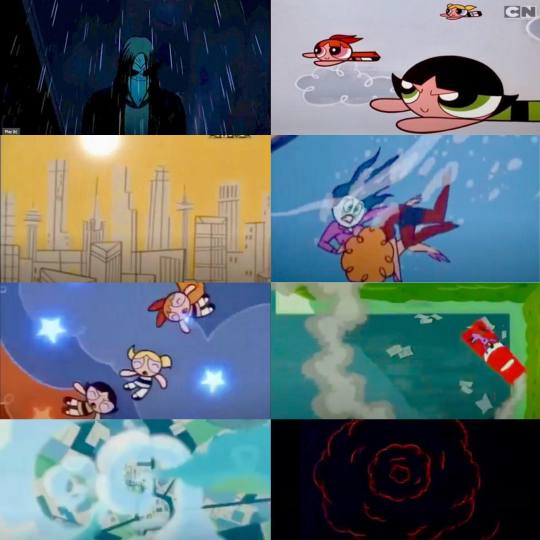
Fig.5. Atmosphere composition : Rainy, Cloudy, Sunny, Underwater, Outer
Space, Smoky, Foggy, Dusty
( Source : Tumblr)
● VISUAL ANALYSIS I :
* Representation :
This distribution includes eight compositions of the layout reflecting the atmospheric weather: Rainy, Cloudy, Sunny, Underwater, Outer Space, Smoky, Foggy, Dusty.
* Where is it located?
The City of Townsville, in the air, underwater and in space.
* How is the characters are placed in the compositional frame? What surrounds them?
- Rainy composition :
In the center of the composition is a man who is strangely smiling. He wears sunglasses while it rains from the sky. Only the upper part of his body up to his shoulders is visible.
-Cloudy composition :
In the foreground is a girl with black hair and green clothes, behind him a girl with orange hair and pink clothes, and behind them a blond girl in blue clothes. All three fly in the clouds.
-Underwater composition :
In the center of the composition are two women surrounded by water who appear to be sinking.
-Outer Space composition :
To the left of the center and below is the girl with black hair and green clothes; in the middle of the composition is a blond girl with blue clothes, and at the top right of the center is the girl with orange hair and pink clothes. They fly (or fall) from the starry sky around them.
* Is their activity presented as typical (or atypical)?
The three girls have superpowers, so the actions they perform can be defined as typical for them.
* Does the design meet the genre expectations?
Yes.
* What is the preferred audience?
Mostly children's audience (over 3 or 4 years), but also for all older children and their parents.
* How is the composition built? Why is the composition built in this way?
- Rainy composition - In dark blue colours, because apparently the action takes place at night. The emphasis is on the figure of the man in the center for which lighter shades of blue are used.
- Cloudy composition - The composition is built in monochrome colours to make the three characters to stand out.
-Sunny composition - Townsville buildings are only presented as outlines (no details).
-Underwater composition - The composition seems to be diagonal and creates a feeling of fluidity due to the position of the bodies of the characters underwater.
-Outer Space composition - Here the feeling of height is achieved through the facial expression and positioning of the bodies of the three girls within the composition, which cannot be the same if the action takes place on the ground.
-Smoky composition - This composition is interesting because of the viewing angle (from above). Maybe that is the point of view of someone who flies.
-Foggy composition - Just like the previous composition in this one the angle of observation it is from above.
-Dusty composition - There are no figures here, and the feeling of dust (smoke) comes from the abstract shape of the black background, in the center of the composition, which resembles smoke after an explosion.
* What is the message here?
The message is that in most cases, girls (women) can have many different abilities to deal with the dangers that surround them.
* Stereotype and its challenge
A stereotypical example here may be that girls have to stay at home where they are well protected because they do not have the necessary strength to deal with the dangers of the world around them.
However, they go out, use their superpowers and prove that this is possible, which challenges the stereotype.
● DECONSTRUCTION :
* Foreground.
In the foreground here can be seeing :
- Rainy composition - A long face man with a strange smile.
- Cloudy composition - A girl flying into the sky.
- Sunny composition - City landscape.
- Underwater composition - Two drowning female figures.
- Outer Space composition - Three flying (falling) girls.
- Smoky composition - Smoke.
- Foggy composition – Clouds.
- Dusty composition - Explosion.
* Background.
In the background can be seeing :
- Rainy composition - Part of the urban landscape of Townsville.
- Cloudy composition - Two more flying girls and clouds.
- Sunny composition - Sunny sky.
- Underwater composition – Water.
- Outer Space composition – Sky and stars.
- Smoky composition - Car and building.
- Foggy composition - A city seen from above.
- Dusty composition - Black sky.
* The shapes in the composition are :
- Rainy composition - Dashes (rain.)
- Cloudy composition - Circles (eyes, heads, clouds.)
- Sunny composition - Vertical and horizontal outlines of buildings.
- Underwater composition - Body shapes (bodies.)
- Outer Space composition - Circles (heads, clouds.)
- Smoky composition - Rectangles and angles (car and building) and Abstract shapes (smoke.
- Foggy composition - Abstract shapes (Clouds.)
- Dusty composition - Abstract shapes (Smoke after an explosion.)
* The colours used are :
- Rainy composition – All shades of blue: from dark to electric blue.
- Cloudy composition – Monochrome gray, black, orange, yellow, green, pink, blue.
- Sunny composition – Orange, beige.
- Underwater composition – Blue, orange, purple.
- Outer Space composition – Blue, orange, black, green, pink, yellow.
- Smoky composition - All shades of green: from dark to electric green.
- Foggy composition – Blue-green.
- Dusty composition – Black and red.
* Positive and negative spaces :
The only composition in which the ratio between positive and negative space is the same is the Sunny composition.
● ICONOLOGY (According to Panofsky's three levels) :
* Rainy composition –
- Level 1 Description : Here you can see a long-haired smiling man on a rainy night. There is a building on his right.
- Level 2 Identification : Мъжът изглежда странно защото носи слънчеви очила докато вали дъжд. He's probably walking down a street because the outlines of a building can be seen on one side of him, and it looks like the light from a street lamp is falling on him.His facial expression is smiling but that smile is sinister rather than benevolent. He seems to be a person who has committed a crime and is happy with it. The night time in which this walk takes place proves this once again because night is the best time to cover up the evidence of the crime, and the rain only reinforces the feeling of anxiety in the whole composition.
- Level 3 Analysis : From ancient times, mankind has known such villains who committed their crimes at night: Bluebeard and Jack the Ripper are among them.
* Cloudy composition –
- Level 1 Description : Herе can be seen a cloudy sky in which three girls are flying.
- Level 2 Identification : The sky is thick gray, there are clouds, which suggests that there will probably be a storm soon. The girl's face in the foreground is angry. The flying girls are in a hurry for somewhere. The posture of their bodies shows their determination and fearlessness. Even the approaching storm cannot stop or frighten them.
- Level 3 Analysis : Historically, such a brave girl-hero is Jeanne d’Arc, whо leads an army, wins many battles and becomes proof of how a young girl can be stronger than many men and win much more than them; Amelia Earhart, who began with her flying experiments at the age of 20 and became the first female aviator who fly solo across the Atlantic Ocean and more recently Greta Thunberg, who is a winner of Human Act Award 2020 and The International Children’s Peace Prize, which is awarded to child who has made a significant contribution to advocating children's rights.
* Sunny composition –
- Level 1 Description : Here can be seen а very high buildings and above them a sunny sky.
- Level 2 Identification : The sun in the sky is almost in the middle of the composition, indicating that it is probably just before noon. There are various office buildings and TV towers, and judging by the height of the buildings, it can be assumed that this is happening in America, because there are cities with similar architecture : Boston, Chicago and New York in America, for example.
- Level 3 Analysis : The Empire State Building is a 102-story skyscraper located in Manhattan, New York. It was built in Art Deco style and it was completed in 1931.
* Underwater composition –
- Level 1 Description : Here can be seen two women drowning underwater.
- Level 2 Identification : Women are not on an equal footing, one of them with orange hair seems to be in the power of the other with black hair. The black-haired woman's face is visible, and it shows that she is furious, while the other woman's face is hidden. Both are wearing clothes, not swimsuits, which shows that they fell under the water not of their own volition, but after an accident.
- Level 3 Analysis : Is it possible that someone standing under water will come to life again? Yes, if his name is Harry Houdini. The magician of the late 19th and early 20th centuries has repeatedly proven that it is possible (albeit with the help of illusion.)
* Outer Space composition -
- Level 1 Description : Here can be seen three girls flying or falling amongst the outer space.
- Level 2 Identification : The girls' facial expressions suggest that they do not enjoy this flight. It seems that someone threw them into space against their will.
- Level 3 Analysis : From 7 to 20 February 2008, a space flight took place with the ship Atlantis. During the flight, the German Hans Wilhelm Schlegel went into space for 6 hours and 45 minutes to prepare the module for scientific work, as well as to replace the spent tank with compressed nitrogen on the station hull.
* Smoky composition –
- Level 1 Description : Here can be seen a stopped car. There are scattered sheets of paper around the car, and smoke can be seen in the air above the car. There is something on top the car that looks like a human body.
- Level 2 Identification : The car is parked diagonally, which is not the usual way to park. Scattered sheets of paper and smoke in the air, as well as the body (if it is a body) on top the car, suggest that an accident may have occurred.
- Level 3 Analysis : Many historically significant figures have died in a car accident -James Dean (1955) who played only three roles but remained forever in the history of cinema; Albert Camus (1960), the "father" of existentialism; Jane Mansfield (1967), considered by many to be the heiress of Marilyn Monroe; Grace Kelly (1982), the muse of Alfred Hitchcock; and the mysterious car crash in Paris that killed Lady Diana Spencer (1997.)
* Foggy composition -
- Level 1 Description : Some irregular shapes can be seen here and some of them are hidden behind a fog.
- Level 2 Identification : It looks like a city view from above. Some roofs of buildings and clouds can be seen. This could be the point of view of a passenger on a plane or someone parachuting.
- Level 3 Analysis : According to Online Symbolism Dictionary " Fog illustrates obscurity, indistinction; in the Bible, it is an image preceding great revelations. It is the "GRAY zone" between reality and unreality, and uncertainty about the future and beyond. According to Browning it can represent approaching death. Isolation. A transformation into the unreal."(1997, 2001)
* Dusty composition -
- Level 1 Description : Here can be seen red circles on a black background.
- Level 2 Identification : The circles are irregular, they have the shape of a cloud that scatters in the air. Resembles exposure after a bomb.
- Level 3 Analysis : A similar sight can be seen after the atomic bomb explosions in Hiroshima and Nagasaki in 1945.
● SEMIOTICS :
* Rainy composition -
A MAN - (Signifier) - A male human being which could be:
- An icon (anatomical look of man; cartoon character.. ) -> (signified)
- A symbol (Jesus Christ, Buddha,John Lennon,Yuri Gagarin -> (signified)
- An index (as a consequence of God, monkey, extraterrestrial project) -> (signified)
* Cloudy composition and Outer Space composition -
A GIRL(S) - (Signifier) - A small female human being which could be:
- An icon (anatomical look of girl; cartoon character.. ) -> (signified)
- A symbol (Greta Thunberg, Little Red Riding hood) -> (signified)
- An index (as a consequence of the relationship between her parents) -> (signified)
* Sunny composition -
URBAN ARCHITECTURE – (Signifier) - The physical appearance of a city.
- An icon ( many buildings built at a short distance from each other.) -> (signified)
- A symbol (London, New York, Tokio) -> (signified)
- An index (The building is a consequence of the planning and technological construction by the man.-> (signified)
* Underwater composition -
A WOMEN (WOMAN) – (Signifier) - A female human being which could be:
- An icon (anatomical look of woman; cartoon character.. ) -> (signified)
- A symbol (Indira Gandhi, Valentina Tereshkova, Madona) -> (signified)
- An index (as a consequence of the relationship between her parents) -> (signified)
* Smoky composition -
A CAR - (Signifier) - Мachine for transportation which could be:
- An icon ( machine that have four tires and transport people.) -> (signified)
- A symbol (Tesla Cybertruck )-> (signified)
- An index ( a consequence of the development of a technical project created by mechanical engineers) -> (signified)
* Foggy composition -
A FOG - (Signifier) - A cloud of condensed water vapor (microscopic droplets or at a temperature below 0 ° C - ice crystals) that starts from the earth's surface and reduces visibility below 1 km. It could be:
- An icon ( water droplets ) -> (signified)
- A symbol ( obscurity, beyond, the zone between reality and unreality) -> (signified)
- An index ( as a result of meeting two air fronts.) -> (signified)
*Dusty composition -
AN EXPLOSION - (Signifier) - Oxidation reaction that produces emission of gases and dust which could be:
- An icon ( Cloud dust after the release of energy in an extreme manner. ) -> (signified)
- A symbol ( Hiroshima and Nagasaki )-> (signified)
- An index ( as a consequence of oxidation reaction that produces large amounts of hot gas.) -> (signified)
● REDUNDANCY AND ENTROPY :
Elements of Redundancy and Entropy can be found in some of the eight compositions.
* Entropy can be seen in Cloudy and Rainy compositions and this is the logo of Cartoon Network. It is clear from the logo that this layout is related to the animation.
* Redundancy:
The element that is not essential for Rainy composition is the building, because the content can be understood without it.
The elements that will not affect the Underwater composition if they are not there are the clothes of both women.
�� BINARY OPOSITES :
* Rainy composition - Light/Darkness
* Cloudy composition – Real / Fantastic
* Sunny composition – High / Low
* Underwater composition – Villain / Victim
* Outer Space composition – Real / Fantastic
* Smoky composition – High / Low
* Foggy composition – High / Low
* Dusty composition - Light /Darkness
Foreshortening:
This approach is often used when the power of one of the characters (usually the villains) or one of their super abilities should stand out in the composition. For example : the power of Sedusa, which is hidden in her hair, as well as her ability to incarnate; the influence that Him exerts on all; the physical strength of Big Billy; the ability of the Mayor of Townsville to fly (but only in sleep).
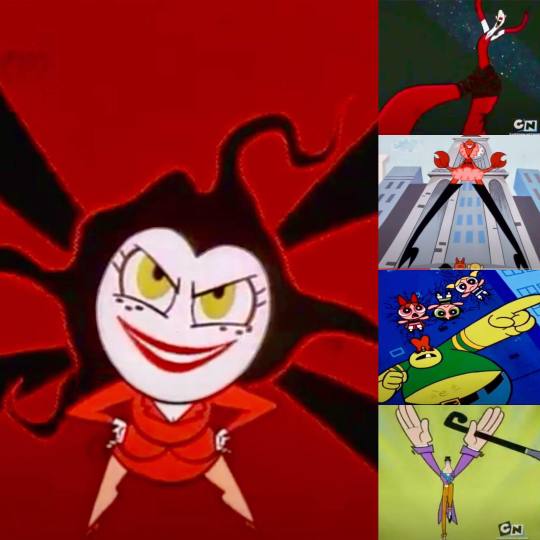
Fig. 6 Sedusa, Him, Big Billy, The Mayor of Townsville
(Source : Tumblr)
In another case, foreshortening in the film it is used to reinforce the stereotype that in order for a woman to be physically attractive, she does not have to be smart (later this stereotype was challenged by Miss Bellum 's actions.) However, in 99 percent of her appearances in the series, she is presented only as a body without a head.
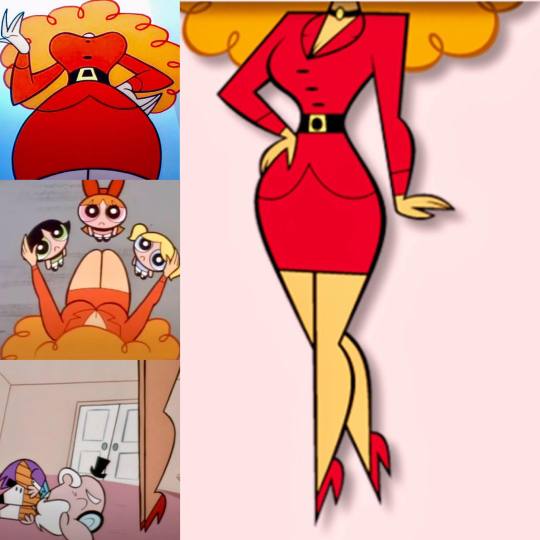
Fig.7 Miss Sara Bellum
(Source : Tumblr)
Complex scenes and the use of 'Dutch angle' in some compositions:
In some more complex scenes, where they have to present several actions at once, the layout artists have divided the field diagonally, which allows them to present two parallel actions in one frame.
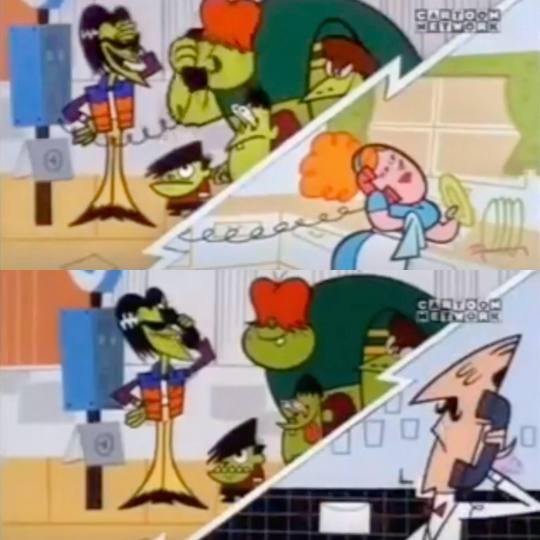
Fig.8 Gangreen Gang I
(Source : Tumblr)
The horizon is usually in the middle of the screen and coincides with the eye line of the observer. But when the scene requires tension and drama, the Dutch angle is used in the composition, which reinforces the feeling of insecurity and instability. In the case of Him, its use is a very good solution because it reinforces the stereotype that sometimes the lack of a clear gender identity can be quite confusing and even frightening.
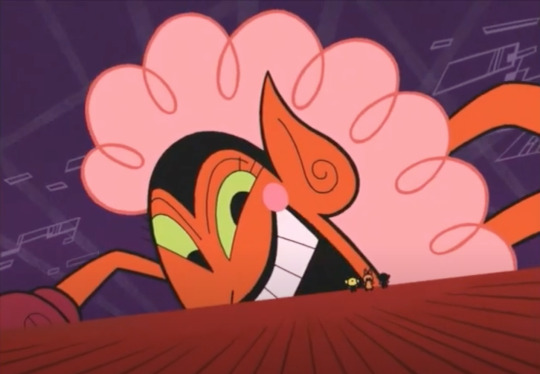
Fig.9 Him
(Source : Tumblr)
But how does it all actually begin?
The year is 1998. A new American animated series about superheroes is conquering the world. This is the story of the three little girls Blossom, Bubbles and Buttercup, living in the city of Townsville, who were invented by their father and scientist Professor Utonium. Girls have superpowers and use them in their fight against evil: starting with local street thugs, and ending with superpowers of universal evil such as insidious demons and vampires.The series was produced by Hanna-Barbera for Cartoon Network and created by animator Craig McCracken. Conceived and developed under the name 'Whoopass Stew!' in the second year of McCracken's studies at the California Institute of the Arts (CalArts), the series debuted in late 1998, has its 6 seasons (78 series), as well as a special edition of the feature film and a special edition of the anniversary film to celebrate the 10th anniversary, as well as various comics, video games, clothes, toys and other franchise and ended in March 2005, winning nominations for six Emmy Awards, nine Annie Awards, and millions of fans around the world.In the animated series, the leadership implicitly belongs to Blossom (orange long hair, pink dress wide black resembling a karate belt and a red bow); the sweetest is Bubbles (blonde braids, sky blue clothing) and the most combative is Buttercup (black short hair, green clothing).
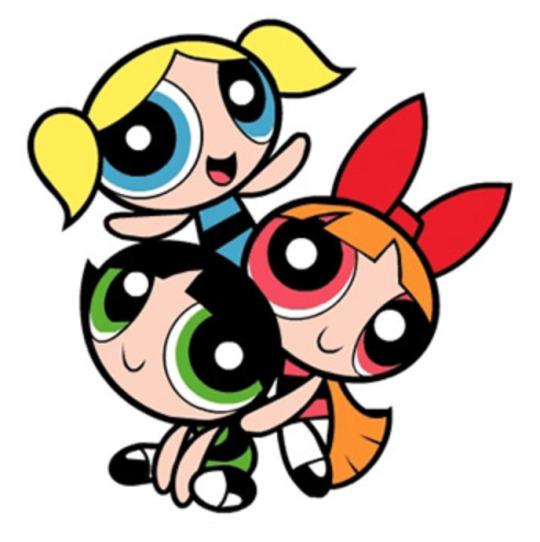
Fig.10 The Powerpuff Girls
(Source: thefluffybunch.fandom.com )
The shape of the body, head and eyes of each of them resembles a circle (in fact, the bodies of all three are disproportionately small and their eyes are disproportionately large relative to their heads), but in fact this deformation, as well as the emphasis on their round shape is not random. Round shapes are characteristic of the feminine principle and thus the idea of dominant feminism is introduced.Initially, nothing threatening is found in the vision of the girls, but if they are confronted by a bully or a villain, they immediately become a real threat to him, showing their super fighting skills, which shatter the traditional notions of ‘femininity’ associated with meekness, shyness and cowardice. Over time, it turns out that McCracken was right about his choice of this type of female superhero; many other films on the subject appeared, and critics began to define the movement of "girl power" that began in the 1990s as feminism from the Third Wave (the Second Wave is typical of the feminist movement of the 1960s.) The new movement does not aim to oppose to the femininity of power, but on the contrary, shows that both are possible together and the result is quite attractive. Many emerging figures and groups stand behind this concept and develop it to varying degrees, starting with the young female punk band of the 90's Riot Grrrls, who first showed that rebellion and femininity are not mutually exclusive concepts, and continuing the trend with the hysteria for a indisputably the most successful girl band in the history of pop music, the Spice Girls, which openly promotes ideas of female power and potential.
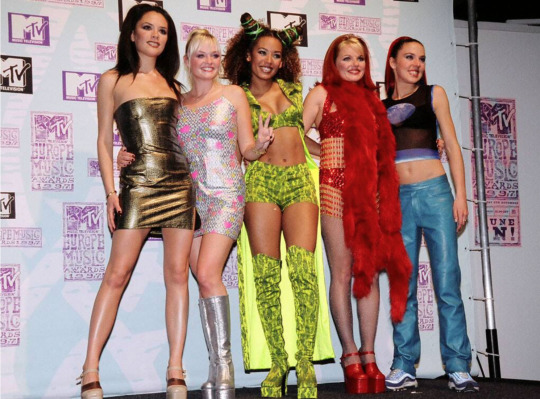
Fig.11 Spice Girls
(Source: eonline.com )
Unlike the feminist generation of the 60s which advocates for gender equality, for privileges of working mothers and against the gender discrimination in applying for job, as well as against sexual abuse against the physically weaker sex, the girls of 90s do not need to be rescued, they do not want to be protected or receive special privileges because of their gender as they can handle everything on their own. They openly and clearly state their place in the world through their behavior, as well as by following the messages in the texts of their favourite girl bands.In the 90s, not only was the dominant male role in society challenged (which is the main merit of The Second-wave feminists) but it went even further by challenging the stereotype that femininity and sexuality were something that should be to be denied (or belittled at best). Young women in the 90's believe that female attractiveness should be manifested as an expression of opportunities and strength. In this sense, maintaining good physical and intellectual condition are mandatory challenges, and films such as "Buffy the Vampire Slayer" (1997) and "10 things I hate about you" (1999) only prove it. In ‘10 Things I Hate About You: Kat, Rom-Com Feminist’ (2020) ,Kat Stratford (Julia Stiles' character) reads Sylvia Plath and chose the role of an antisocial and self-sufficient feminist, because she is fully aware the strength of her intellect and abilities, but in the same moment she is attractive, smart and physically fit young woman.
So, is the fictional character Lara Croft from the 2001 series of video games and film, who portrays her as a smart and physically fit young archaeologist who takes risks and copes no worse than men with many challenges on the way to achieving her goals, and thus becoming a role model for a thousands of young women of her generation.
As can be seen, in 90s the women can be strong and independent and to deal with their enemies alone and from this current point of view the myths about their dependence on men remains in the past.
From all the above it can be concluded that in creating the three Powerpuff Girls, Craig McCracken is not only influenced by all these processes, but also manages to visually present the destruction of the stereotype for the weakness and insecurity of femininity, as well as myths about the social and role of women dependent on men in a particularly original way through the interactions of Blossom, Bubbles and Buttercup with the rich variety of the other characters in the series.
Conditionally, the interaction with these characters will be divided into four groups:
- interaction of Powerpuff Girls with a female characters,
- interaction of Powerpuff Girls with a male characters,
- interaction of Powerpuff Girls with a creatures and
- interaction of Powerpuff Girls with non-heteronormative characters,
and a comparison will be made between the Powerpuff Girls and one representative of each one of them.
Among the interaction of Powerpuff Girls with the other female characters stands out one - that of glamorous assistant Miss Sara Bellum. This character challenges one traditional stereotype. Her emphatically feminine appearance (and as already commented more precisely her body because her head is missing) does not necessarily mean that she is stupid, but on the contrary; when necessary, she can make the right decisions and even be quite 'intellectually sharp'.
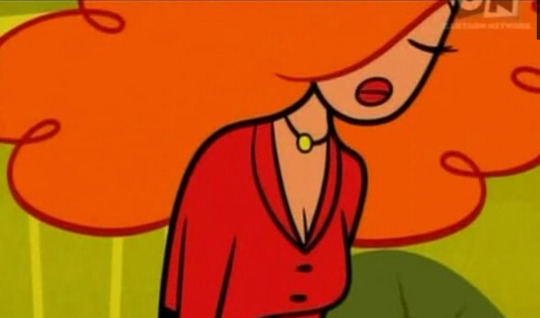
Fig.12 Miss Sara Bellum’s head
(Source : Fandom.com)
As for the interaction of the Powerful Girls with the male characters, there is a kind of "competition" between them. This is clearly evident in the interaction of girls with Gangreen Gang - a group of troublesome hooligans and bandits, known for their antisocial behavior, who live in the town dump in Townsville. Among their members are Ace, Snake, Lil 'Arturo, Grubber and Big Billy. The boys are mostly known for committing petty crimes, such as vandalism and harassment of the young or elderly. (Ace has to some extent "evolved", replacing a member of the Gorillaz who was imprisoned for a while). The Gang are characterized by their green skin, and all the gang members have black hair, except for Big Billy, who has red hair. They appear to be teenagers, but they vary widely in height and body type. Their species is mutated human.
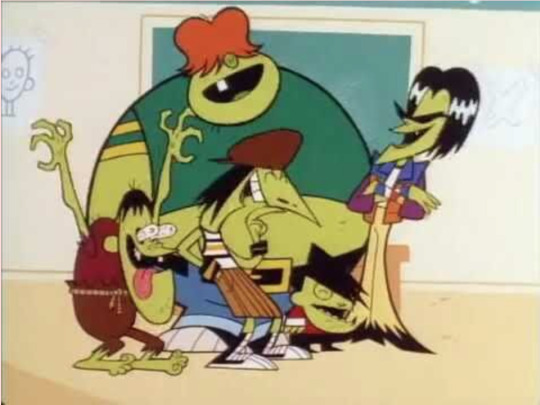
Fig.13 Gangreen Gang II
(Source : Fandom.com)
The three girls, however, worthily oppose and manage to defeat them, not only because they use their physical superpower, but also because they can be friendly and smiling and say "please" and "thank you." Thus, another stereotype is challenged - that of the Second-wave feminists, who are traditionally bad, while Craig Mkraken's heroines behave in a traditionally acceptable way.
The other characters in the animated series are portrayed according to traditional notions of gender stereotypes: Townsville's female characters are portrayed as cowards (for example, they are afraid of insects until someone fearless man comes to save them), while the male characters are portrayed as aggressive. Fuzzy Lumpkins, Amoeba boys and especially Mojo Jojo, who is the main antagonist and the main enemy of Professor Utonius and the strong girls, are constantly planning to conquer the world or at least cause harm to someone in the neighbourhood. Mojo spend a lot of his time inventing a new weapons or technology and even on several occasions his plans succeeded.
At the end, the feminine principle wins again, thanks to a typical feminine quality that men can't stand: being nice. In this way, the female 'being nice' becomes a super power, but falling into male hands, it is again subjected to destructive criticism, which reinforces the gender stereotype.
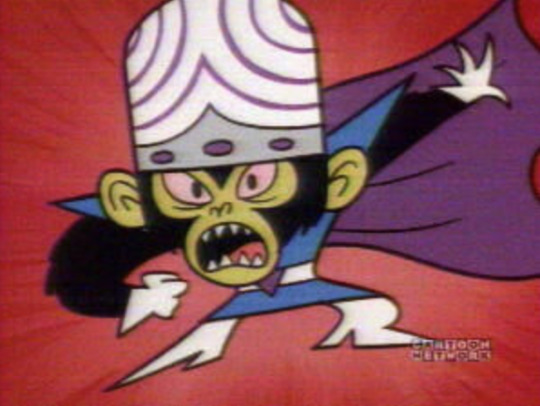
Fig.13 Mojo Jojo
(Source : Fandom.com)
After all this, however, there is a more special kind of interaction between the girls and someone who is 'a villain so evil, so sinister, so horribly vile that even the utterance of his name strikes fear into the hearts of men. The only safe way to refer to this king of darkness is simply... HIM." With these words this mysterious character is represented by The Narrator in the episode ‘Octi Evil’.
What do we know about this mysterious being? Very little. - Him is a highly manipulative creature that has a high enough charisma that he persuade and manipulate the beings; - He is an all powerful being. The most powerful in the world second only to thegirls. Or at least, that is what the series wants us to think; - He has a interesting relationship with the professor. Usually the focus is on his atypical (unrecognizable) gender identity and here the confusion comes from the fact that he speaks with an ominous high voice and wears high heels and sock nets, which is a sign of non-heteronormativity, according to the existing stereotype. Can this strange and contradictory character really be characterized as non-heteronormative and can this characteristic contribute to the naturalization of prejudice or the exclusion of groups that identify as non-heteronormative (such as Queer.) According to Goodreads " Queer identitites may be adopted by those who reject traditional gender identities and seek a broader, less conformist, and deliberately ambiguous alternative to the label LGBT."(Goodreads,2020)
As a result of the above, the following question arises: can Him, who embodies the world's super-evil, serve as an ideological support to viewers whose beliefs and cultures mock non-heteronormative people and violate their rights? And is his characterization of super-evil really related to his unclear gender or is it a consequence of his unacceptable social behavior?
Interesting is the opinion of Dennis, according to which "Him presents the latest trends in animation that show homosexuality as "either stupid or sinister" (p. 138, 2003) and he is about to be right because in the new animated version of "Mr. Magoo" released in 2019, the assistant of the main antagonist called Little Weasel is again presented with the characteristics of a non-heteronormative person, which again raises the question of why (and is it correct) to use a non-heteronormative character in a villainous role and in a negative context? What causes the construction of such a stereotype in the minds of young viewers?
On the one hand, it is good for children to be prepared for life, because in it they will encounter all kinds of challenges and all kinds of people (Him could be of any gender); on the other hand, what makes Him really evil and dangerous is his manipulative nature and the fact that he is a collection of contradictions. The interaction with someone who has similar behavior in the real life can always deceive or confuse them, because they are often not well prepared and they don't know how to react.
This essay stands behind the thesis that the feeling of absolute evil in the series does not come from the non-heteronormative man (Him), with whom the Powerpuff Girls often interact, but is the result of the contradictions from which this character is built: Santa Claus and Satan; human body and legs and lobster clamps instead of arms; a voice as thin and attractive and as powerful and furious as lightning. https://www.youtube.com/watch?v=wd3PJHCrQ7k
The contradiction inherent in his nature causes shock and horror in the observer, not the lack of gender identity. This character once again emphasizes the fact that evil is stronger than all genders and individual traits.
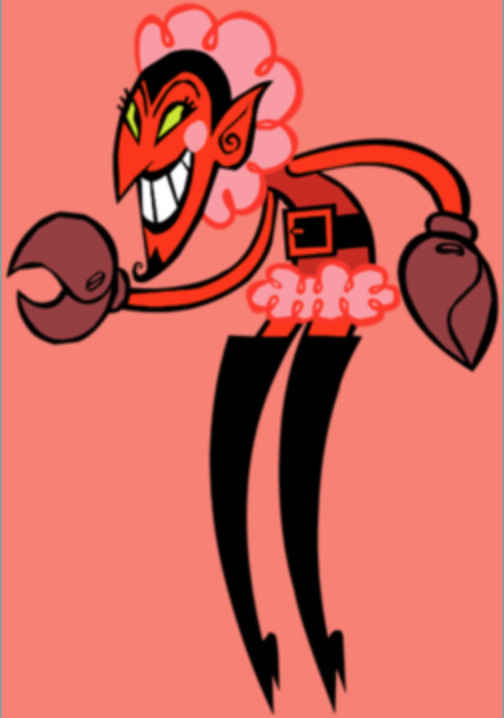
Fig.14 HIM
(Source : Fandom.com)
Although this essay supports the notion that to be non-heteronormative is not something perverted and dangerous that adults should protect children from, the animated series "My Little Pony: Friendship is Magic" which appeared 12 years after "Powerful Girls" is evidence of how indirectly an animation designed for young girls can become a challenge to the social construction of gender through the subsequent manifestations of subculture (a different folklore currents and communities such as "Bronies", or Japanese postmodern art movement known as "Superflat", and - why not - the art sharing platform DeviantArt / partly /.)
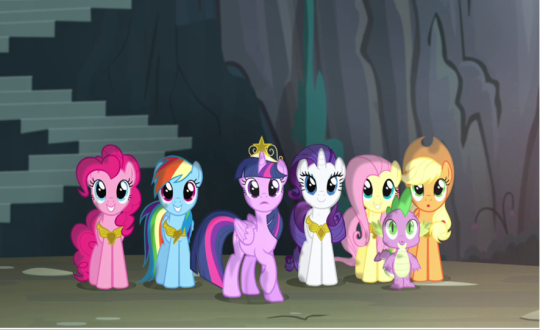
Fig.15 My Little Pony : Friendship is Magic
(Source : Fandom.com)
The last discussion in the essay will be related to the question of why animation intended for a target group of little girls, such as "My Little Pony", affects a certain group of people (young men who call themselves ‘bronies’) and how they interpret the gender stereotype of the cartoon characters (or lack thereof). What is the role of children's animations in the creation and development of a subculture, such as the network of Bronylore sites?
Although Lauren Faust, creator of "My Little Pony" and wife of Craig McCracken, (who previously worked with him on "The Powerful Girls") is adamant that the 'My Little Pony : The Friendship is Magics' was conceived and implemented as an animation for little girls, this series is becoming very popular among an unusual demographic audience of young men who call themselves "Bronies" (The term is a sum of the abbreviated "bro" and "pony" and distinguishes adults fans, most often ages 18 - 34 who follow" My Little Pony : Friendship Is Magic" from the target audience of young girls.) The Bronies use "4chan" or create their own network of online sites "Bronylore", where they publish their comments and comics related to the show. Why this series has such an impact on these young men and how the bronies interpret the gender stereotype of the pony cartoon characters (or lack thereof)? According to Claire Burdfield "Riley Kilo, a Brony and 4chan user, stating that “people were attracted to the cuteness of the pony avatars”.(Burdfield, 2017) This essay assumes that this is possible because the animation, itself, allows the bodies of the characters to be reshaped in ways that transgress conventional barriers of sexuality and allow viewers a much wider scope in which to explore alternative ways of seeing the place of gender identity within human society. But what the essay emphatically does not accept is the fact that Bronylore identifies potentially transgressive themes in My Little Pony, develops them in deliberately uncomfortable ways, and neatly adapts them to real-life issues relevant to its followers’ social and psychological lives. With this, this sites become a danger for the real target group, this still unformed audience of little girls and boys, who could get a misconception about the meaning of concepts such as friendship, love, cooperation, with an only one wrong click on such a site - something that the creators of the animated series would definitely not want to happen.
With all of the above, an attempt was made to look into the world of modern animation by comparing existing gender and behavioral stereotypes in society and their reflection in the children's animated series "Powerful Girls" and "My Little Pony: Friendship is Magic".
- Descriptive and comparative methods were used, as well as semiotic analysis, to clarify the role of composition as a natural environment where the characters operate and supporting factor for their behaviour.
- By comparing relationships: girls (courage, strength) / boys (defeat); young (energy, opportunities) / old (weakness, incompetence, helplessness, infantilism) were challenged some of the stereotypes in society.
Other existing understandings were challenged, such as that female beauty and glamorous appearance does not necessarily mean that women are stupid or girl's brilliance and beauty as more necessary than knowledge and learning.
- Through historical review and documentary facts, the terms "Second Wave Feminism" and "Third Wave Feminism" were examined and compared, and evidence of their impact on the creation of the cartoon characters Bubbles, Blossom and Buttercup was applied.
- The question of why (and whether it is correct) to use "non-heteronormative" gender in villainous roles was answered as part of a broader discussion of the relationship: gender - social behaviour. The essay defended the position that it is not gender that makes a character good or bad, but his social behavior. This also protected the rights of certain social groups, such as Queer society.
- Using modern data, in a broader context were analysed some manifestations of the subculture, which arose as a result of the impact of the animated characters from the series "My little pony: Friendship is magic" on certain social groups. An answer was given to the question of what provokes these certain groups of fans to self-identify as "Bronies" and to create digital content on specialised sites.
After the whole study, the academic literature and working on this essay, my belief that I wanted to practice animation became even stronger. I have the feeling that one of the most prominent schools in the world for training of such significant contemporary animators as Craig McCracken, Lauren Faust, Genndy Tartakovsky (Dexter's Laboratory, 1996) and a decade later - Pendleton Ward ( Adventure Time, 2010) is the California Institute of the Arts (CalArts) and my desire to deepen my knowledge, moving forward with a master's degree in animation, takes me exactly there. Moreover, Cartoon Network Studios (my most dreamed workplace as a future practitioner) is also located there, in California. Of course, it's just a dream for now, but as Bubbles said : "You should do what you want to do."��And Blossom would add : "Being a Powerpuff Girl isn't about getting your way...It's about using your own unique abilities to help people and the world we all live in."
REFERENCES :
● Alex J Taylor, Mr Magoo and Modern Art, Oxford Art Journal, Volume 42, Issue 3, December 2019, Pages 412–414, https://doi-org.ezproxy.herts.ac.uk/10.1093/oxartj/kcz015
● BBC, (2020), Second Wave Feminism, [Online], Available at: https://www.bbc.co.uk/archive/second-wave-feminism/zdhw382?fbclid=IwAR0CgNwQQ01Zx8KZTs7OXpt2zQ7x7b3baPrH2J2zYOnpu2lF2pLsMPqmjfA , [Accessed 18 Oct.2020]
● Burdfield C.,(2017), A brief history of the 4chan ‘Pony Wars, [Online], Available at: https://cstonline.net/a-brief-history-of-the-4chan-pony-wars-by-claire-burdfield/?fbclid=IwAR1nWN411GjOsah3AFcDgEsxgAOM5iWgzLtKdORGKHxjKWeQLEoKnbFHxZs , [Accessed 18 Oct.2020]
● ELLIS, B., 2015. What Bronies See When They Brohoof: Queering Animation on the Dark and Evil Internet. Journal of American Folklore, 128(509), pp. 298-314,369-370.
● Goodreads, (2020), Queer, [Online], Available at: https://www.goodreads.com/genres/queer?fbclid=IwAR0UXLjDqiOC_Hk2RwrLglZcMY2G6iPFofxJMlsiTsuwq1oQOvzifXNx1ZU , [Accessed 18 Oct.2020]
● Griffin, M., Harding, N. and Learmonth, M. (2017) ‘Whistle While You Work? Disney Animation, Organizational Readiness and Gendered Subjugation’, Organization Studies, 38(7), pp. 869–894. doi: 10.1177/0170840616663245.
● Hager Lisa, (2008), Saving the World Before Bedtime : The Powerpuff Girls, Citizenship, and the Little Girl Superhero, Children's Literature Association Quarterly Volume 33, Number 1, Spring 2008 Johns Hopkins University Press , Article
● Kirkland, E. (2010) ‘The Politics of Powerpuff: Putting the ‘Girl’ into ‘Girl Power’’, Animation, 5(1), pp. 9–24. doi: 10.1177/1746847709356643.
● Knight G.L. (2010), Female Action Heroes : A Guide to Women in Comics, Video Games, Film, and Television, Publisher ABC-CLIO, LLC, p. 228-237
● Richter K.,(2010), My Little Homophobic, Racist, Smart-Shaming Pony, [Online], Available at: https://msmagazine.com/.../my-little-homophobic-racist.../ , [Accessed 18 Oct.2020]
● Rosenfeld M.,(2000), Powerpuff Girls: Good Guise, Bad Guys, [Online], Available at: https://www.washingtonpost.com/archive/lifestyle/2000/12/26/powerpuff-girls-good-guise-bad-guys/79a54733-9e40-4633-a5c4-46c040bff6c2/ , [Accessed 18 Oct.2020]
● Santos, G., Mancio, C. P., & Maranho, E. (2019). Queer representation incorporated at “Him”, character of “The Powerpuff Girls". Journal of Science and Technology of the Arts, 11(1), 11-21. https://doi.org/10.7559/citarj.v11i1.588
● Schmidt G.,(2016), Cartoon Network’s Powerpuff Girls Fight Evil on TV and Beyond, [Online], Available at: https://www.nytimes.com/2016/04/04/business/media/cartoon-networks-powerpuff-girls-fight-evil-on-tv-and-beyond.html?fbclid=IwAR262Wmc4CU-5uN33JczcQnvr8Q7BOc9PXKi7UNp0O_gpxouSz3vnO8foOs , [Accessed 18 Oct. 2020]
● The Take,(2020), Is the character HIM from “The Powerpuff Girls” transgender? [Online], Available at: https://the-take.com/watch/is-the-character-him-from-the-powerpuff-girls-transgender?fbclid=IwAR3Ubj88aK55Zv4MY_tD5vapAdZGq8KmbBom0fHjnA1KYBZJwjPYH82UdUA , [Assecced 18 Oct.2020]
● Wineman D.,(1998), SIGNOFF; Never Underestimate the Power of a Puff, [Online], Available at: https://www.nytimes.com/1998/11/15/tv/signoff-never-underestimate-the-power-of-a-puff.html?fbclid=IwAR0ylJhQJ11WVzoTKHq7GR-wyIXjix6uMDv8TrXvFUEMdIZxz5eCdDbuus4 , [Assecced 18 Oct.2020]
LIST OF ILLUSTRATION :
Fig.1. The City of Townsville [online image] Available at: https://powerpuffgirls.fandom.com/wiki/Townsville?fbclid=IwAR3K_KazdzNZdCXBLY89bcQVCf4ffktRpe5P4Q4yCK-gNFobQ1fgmw6RJls , [Accessed 15 Oct 2020]
Fig.2. Ponyville [online image] Available at:
https://mlp.fandom.com/wiki/Ponyville?fbclid=IwAR3N6cqy-H-xhT9kjoe4w7OwDzoqfreRRaqxBeiSeDYJBpOm5JELMcjo0D8 , [Accessed 15 Oct 2020]
Fig.3. The bedroom of Powerpuff Girls [online image] Available at: https://weheartit.com/entry/327702990
[Accessed 15 Oct 2020]
Fig.4. Fluttershy's bedroom [online image] Available at: https://www.derpibooru.org/1144404 ,
[Accessed 15 Oct 2020]
Fig.5. Atmosphere composition : Rainy, Cloudy, Sunny, Underwater, Outer Space, Smoky, Foggy, Dusty [online image] Available at: https://madoddball.tumblr.com/post/635218255016067072/how-the-animation-series-powerpuff-girls-and-my?fbclid=IwAR2wYp-NQXROdoxU8QWJTZnU86s0yLL2PX8RC2yVttpN3FXXgYllI-eEDMM , [Accessed 9 Dec 2020]
Fig.6. Sedusa, Him, Big Billy, The Mayor of Townsville, [online image] Available at: https://madoddball.tumblr.com/post/635218255016067072/how-the-animation-series-powerpuff-girls-and-my?fbclid=IwAR2wYp-NQXROdoxU8QWJTZnU86s0yLL2PX8RC2yVttpN3FXXgYllI-eEDMM , [Accessed 9 Dec 2020]
Fig.7. Miss Sara Bellum, [online image] Available at: https://madoddball.tumblr.com/post/635218255016067072/how-the-animation-series-powerpuff-girls-and-my?fbclid=IwAR2wYp-NQXROdoxU8QWJTZnU86s0yLL2PX8RC2yVttpN3FXXgYllI-eEDMM , [Accessed 9 Dec 2020]
Fig.8. Gangreen Gang I, [online image] Available at: https://madoddball.tumblr.com/post/635218255016067072/how-the-animation-series-powerpuff-girls-and-my?fbclid=IwAR2wYp-NQXROdoxU8QWJTZnU86s0yLL2PX8RC2yVttpN3FXXgYllI-eEDMM , [Accessed 9 Dec 2020]
Fig.9. Him I, [online image] Available at: https://madoddball.tumblr.com/post/635218255016067072/how-the-animation-series-powerpuff-girls-and-my?fbclid=IwAR2wYp-NQXROdoxU8QWJTZnU86s0yLL2PX8RC2yVttpN3FXXgYllI-eEDMM , [Accessed 9 Dec 2020]
Fig.10. Powerpuff Girls [online image] Available at: https://thefluffybunch.fandom.com/wiki/The_Powerpuff_Girls , [Accessed 15 Oct 2020]
Fig.11. Spice Girls [online image] Available at: https://www.eonline.com/news/1042491/every-time-the-spice-girls-playfully-shaded-victoria-beckham-over-skipping-their-reunion-tour , [Accessed 15 Oct.2020]
Fig.12. Miss Sara Bellum’s head [online image] Available at: https://powerpuffgirls.fandom.com/wiki/Sara_Bellum_(1998_TV_series)?fbclid=IwAR28VwKq-1fvlplwTQKAdbVC7TaXwe-ChTXnl0vUTWCSMrWrumKMK15Q2X8 , [Accessed 15 Oct 2020]
Fig.13. Gangreen Gang II [online image] Available at: https://powerpuffgirls.fandom.com/wiki/The_Gangreen_Gang/Gallery?file=Gangreen_Gang_laugh.jpg , [Accessed 15 Oct 2020]
Fig.14. Mojo Jojo [online image] Available at: https://powerpuffgirls.fandom.com/wiki/Mojo_Jojo_(1998_TV_series)?fbclid=IwAR0Tieaf6nn877NUbcMH2Y5yhrETvy3Ggg381DVl6PH66J_XOlC92DvDPAk , [Accessed 15 Oct 2020]
Fig.15. Him II [online image] Available at: https://powerpuffgirls.fandom.com/wiki/HIM?fbclid=IwAR3xrLszNdwPo_m9dyqOUqcafQVvGO_cwcNxtc0W-i2LzI8EiskxkSMxv4Y , [Accessed 15 Oct 2020]
Fig.16. My Little Pony : Friendship Is Magic [online image] Available at : https://mlp.fandom.com/wiki/My_Little_Pony_Friendship_is_Magic , Accessed 15 Oct 2020]
VIDEO SOURCE :
10 Things I Hate About You: Kat, Rom-Com Feminist (2020),video, The Take, Available at : https://www.youtube.com/watch?v=3XevO7MCmGY&t=984s , [Accessed 9 November 2020]
Status: Submitted
All content copyright © 2020 v_onyeukwu
#degree essay#script#stereotypes#behaviour#female#male#queer#bronies#LaurenFaust#craig mccracken#powerpuffgirls#mylittlepony#animationmypassion
9 notes
·
View notes
Text
Michael in the Mainstream - Spider-Man: Far From Home/Spider-Man: Into the Spider-Verse
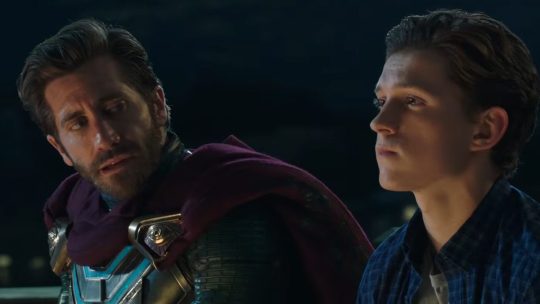

It really is a good time to be a Spider-Fan.
This guy is hitting all the right notes lately: he’s got a great video game beloved by all who plays it, he’s one of the golden boys of the MCU after only a handful of appearances, and he featured in one of, if not THE greatest animated movie of all time. Now if only his comics would undo One More Day and they renewed Spectacular Spider-Man and gave it the finale it deserves, things would be absolutely perfect.
So with me being a big Spider-Man fan, I think it’s about time I talked about his greatest cinematic achievments: Into the Spider-Verse and Far From Home. That’s right, Spidey is so good he’s conquered two mediums and delivered his best stories within a year of each other. My only regret is not talking about both of these films sooner, but I suppose that just gives me the opportunity to praise them both at once.
The greatest common factor these two movies have between each other, and what makes both films infinitely relatable and entertaining, is how both films feature a young protagonist who has great responsibility thrust upon them and they must find some way to deal with it. In the case of Peter, he is saddled with the pressure of being able to live up to his mentor, Tony Stark, in the wake of Endgame’s finale and Tony’s sacrifice. Frankly, Peter just wants to be a normal teenager, get the girl, and have a good vacation – it’s perfectly understandable, and while it may come off as a bit selfish, Peter is still a young man, a young man who has suffered through numerous traumas in his life and is probably upset he can’t just be normal for once. Of course over the course of the film he remembers that with great power comes great responsibility, and he rises up to save the day.
Miles, on the other hand, while initially a bit confused and unsure of himself and what to do, really does want to live up to the memory of Spider-Man, who he only knew a brief time before his death. However, he lacks training, he doesn’t understand his own powers, and he just lacks faith in himself. The entire movie builds up his character, his relationships to others, and all he does so that moment when he takes his “leap of faith” is well-earned and solidifes the moment when he goes from merely being a Spider-Boy to truly earning the name of Spider-Man. I find it very interesting how the two Spider-Men in the two best Spidey movies have sort of opposite motivations – one is being crushed by the pressure to be a world-saving hero while only wanting to be normal, while the other wants to live up to the destiny thrust upon him but initially lacks the skill and finesse to do so – before coming to the same sort of ending. More than the man in the comics who sold his marriage to a demon because he couldn’t deal with the consequences of his actions, these Spideys realize the immortal phrase from Uncle Ben that I need not repeat.
Of course, what would a hero be without a villain to oppose them? Thankfully, both films deliver some of the best superhero movie villains anyone could ask for. Far From Home is a bit more focused, giving us one major antagonist: Mysterio, in the least shocking movie twist of all time. But it truly is a testament to how great an actor Jake Gyllenhaal is and how good a character Mysterio is that he is able to sell you on all of his hero garbage right up until the reveal, and even afterwards he never once drops that affable charm and charisma that belies his true nature as a petty sociopath. Mysterio has always been a character who has struggled to find good use in the comics due to writers not knowing how to use him; he does not have that problem here.
Into the Spider-Verse, on the other hand, goes for what most Spider-Man movies tend to do: cram a bunch of villains in and see what sticks. Thankfully, they manage to hit home runs three out of six times and only whiff twice. Let’s get the less impressive villains out of the way first: Tombstone and Scorpion. While Scorpion’s design is cool and he gets some decent fight scenes, he really could be swapped out with a generic mook and it really wouldn’t make any difference either way. Tombstone, on the other hand, is an absolutely pointless waste of a character, which is a real shame. He’s the bodyguard for a guy who killed Spider-Man with his bare hands and has superhumans and cyborgs under his employ, he’s frankly a bit superfluous. Green Goblin is the only middle ground villain, one who isn’t amazing but is certainly cool enough in his own right to leave an impression despite only having a single scene. His monstrous design really goes a long to selling his threat level and his brutal fight with the original Peter really is impressive. Sadly, he dies at the end of the fight and is quickly overshadowed.
Then we have the two side villains that really work: Prowler and Dock Ock. Prowler is the obvious one, as due to him being Miles’ uncle he adds a sort of tragic emotional connection, one that is only exacerbated once Prowler hesitates in killing his nephew and ends up becoming Miles’ stand-in for Uncle Ben. Dock Ock is a bit surprising, seeing as she is a somewhat unique take, essentially a genderbent original character version of Otto Ocatavius, complete with all that implies (yes, I am talking about the relationship with Aunt May). She’s been the big breakout villain of the movie, and with good reason: she’s cool, she’s cunning, and she’s hot, all hallmarks of a quality villain beloved by the masses.
And then we come to the big one, and I do mean big: Kingpin. Here, his size and intimidation is played up for all its worth, turning him into an absolute mountain of a man and giving him one of the slickest designs I have ever seen. He’s a brutal, ruthless thug, but he’s also given a legitimately tragic and heartbreaking reason to his actions, and while it certainly doesn’t redeem him, it does make him an interesting and complex character. If nothing else, it’s just really nice to see Liev Schreiber finally get to be the villain in a good superhero movie and a good animated movie villain, after getting the shaft in both regards on two previous occasions.
The ensemble casts of both films are great. Far From Home ropes in Maria Hill and Nick Fury, and finally gives Hill some more to do while letting Fury have a lot more fun and taking a more direct approach than usual. Aside from that, all the returning characters are improved – Happy is nicer, funnier, and a better mentor; Dash is still a jerk but he’s toned down and has a bit of tragedy to him; and MJ is fleshed out, given a personality, and has excellent chemistry with Peter. And then there is Peter’s best buddy Ned, who gets ne of the funniest romantic arcs I have ever seen in a movie. And I’d be remiss to not mention Peter’s bumbling teachers, who deliver some more top quality humor to the proceedings. I think it would be best to state now that Far From Home is honestly really funny, with pretty much all of its humor hitting the bullseye, and a lot of that has to do with just how well these people play their parts and dive into their characters with the sort of fun conviction you’d want out of Spider-Man characters.
Into the Spider-Verse has the heavily advertised Spider-Ham, Peni Parker, and Spider-Man Noir, but they actually only appear in the last third of the film and really only stick around to showcase how good the animation can handle other styles, fuel jokes, and help fight in some awesome fight scenes. Frankly, this is enough; they don’t really stick around long enough to overshadow Miles, but they’re also around just long enough to establish personalities and endear themselves to the audience. Out of the three, I find Peni to be the least interesting due to changing her mecha’s design from the more Evangelion-esque one from the comics as well as her just not really grabbing my attention all too much, but it’s easy to see why she has fans. Personally, I preferred the cartoony antics of Spider-Ham and the noir-tinged grittiness of Noir. Also, Noir is voiced by Nicolas Cage and Ham is John Mulaney. It would be a challenge for me to not love them.
The major supporting characters are Peter B. Parker and Gwen Stacy, and both manage to be great in their own right while, again, not overshadowing Miles, with Peter especially being an absolute blast, giving us the miserable, chubby, downbeat Peter we never knew we needed and having him go through a full arc of his own where Miles helps him overcome his hangups as much as Peter helps Miles. Gwen is a fun character, but she sadly doesn’t get quite as much of an arc as Peter, but that will definitely be expanded upon in sequels; she’s still a solid sidekick here. The rest of the supporting cast, such as Miles’ dad, are solid characters, and the film also gives what may be the best version of Aunt May ever (though all Aunt Mays are great and let no one tell you different); I don’t really think the supporting cast is quite as good as Far From Home’s overall, but it certainly does have memorable characters that will stick with you.
Before wrapping up, I of course have to address this: Spider-Verse has some of the most amazing animation I have ever seen. It truly captures that look of being taken right from a comic book, and there are just so many clever visuals and shots that it’s simply astounding. This is the pinnacle of CGI, and revolutionary in the field of stylized CGI. I hope other studios take notes on how to make CGI look good and stylish like this.
Into the Spider-Verse is just a stunning piece of animation. It has good characters, a solid plot, a lot of great humor, a lot of great emotion, and some really decent morals, all while paying tribute to the comics and the Raimi films and giving us some closure by adapting bits of the unused Raimi Spider-Man 4. It’s a beautiful tribute to everything we know and love of Spider-Man while also being a fantastic “passing the torch” story that gives Miles his own time to shine in the spotlight. This movie is basically what Big Hero 6 tried to be, but where that movie kind of stumbled over itself and felt more like a TV pilot for a series on the big screen, this feels like a fully fledged story unto itself. It also has one of the most beautifully poignant Stan Lee cameos ever, as well as what may be the greatest joke in Spider-Man history after the credits. If you love Spider-Man, see this movie. If you love animation, see this movie. If you love movies, see this movie. This might very well be the greatest animated film of all time, and it deserves to be seen.
Far From Home, meanwhile, is a fantastic achievement in live action Spidey cinema. It gives us a wonderful supporting cast, a love interest who actually has chemistry and isn’t a boring damsel that disgraces the name of her comic counterpart, an awesome villain, and genuine funny moments, and for once all of these things are in the same moment! This really solidifies MCU Spider-Man as being a fun, fresh take on a character who has been done to death in almost every medium; it keeps most of what we love while changing some details here and there so that Spider-Man can resonate more with modern audiences. What they do change tends to be for the better, too – I really have no problem, unlike a lot of people, with Tony “taking Uncle Ben’s place,” for a variety of reasons but not the least of which is the fact I’m frankly tired of seeing Uncle Ben die. Having him merely be the long dead motivator for Peter’s early heroics is enough for me. This is absolutely peak MCU, and a fantastic epilogue to the Infinity Saga. If you’re invested in the MCU or Spider-Man at all, this movie will be right up your alley. If you still need more convincing: they combined Raimi Jameson and PS4 Game Jameson into a character, and Simmons still plays him.
Both of these films are the cream of the crop when it comes to cinematic versions of Spider-Man, with Far From Home sitting comfortably up there with Spider-Man 2, if not surpassing it, and Into the Spider-Verse frankly taking on a league of its own, Both projects really alter the course of what can be done with Spider-Man, and it has me excited for all the future works involving the Friendly Neighborhood Spider-Man we might be seeing soon. With Spider-Verse getting sequels and spinoffs and Far From Home absolutely getting a sequel, it’s safe to say that anyone who loves Spidey will have plenty to love for years to come. And the best part is we will never have to worry about either Spidey making deals with Mephisto.
#Michael in the Mainstream#Review#movie review#Spider-Man#Into the Spider-Verse#Far From Home#MCU#Sony#superhero movie#superhero#Marvel
11 notes
·
View notes
Text
Notes for The Vanishing Prince, Chapter 4
It’s Chapter Four, hurray! This one turned out a little differently than I expected… Mostly because the scene at Rakuzan ended up being so long. But I decided to keep it as is, because I just love Rakuzan’s team SO MUCH. <3
So as promised, this was Rakuzan’s turn to have a cameo (and by cameo I mean a super long scene, with loads of love for the Uncrowned Kings and especially Reo).
Also, I ended up including screenshots from the anime in this post! So if you’re interested in a basic breakdown of my theory about why scenes like this one prove that psychic phenomena were included in the show from the beginning:

Well read on, friend. BECAUSE OH DO I HAVE THEORIES ABOUT THAT.
(Cut for stuff about Rakuzan, a little about why I love the Uncrowned Kings so much, even more love for Reo, a brief explanation of some of the supernatural/psychic references, and a seriously epic yudofu restaurant because tofu is Akashi’s first love, obviously)
On Rakuzan’s Campus
It was fun to try to figure out what Rakuzan as a school would be like… I’ve had a headcanon for a while that each member of the Generation of Miracles chose a high school (and a team) that generally reflected their personality and priorities. So my version of Rakuzan has a lot of Akashi-esque qualities to it. XD
Canonically, Rakuzan is supposed to be a prestigious school that excels in multiple areas. That’s one reason why I included OCs in this chapter, to show that Akashi is far from being the only overachiever at his school. Which, as Furihata realizes, makes his status at the school that much more impressive! (Plus I like to fill out different areas of characters’ lives that we don’t get to see in canon, sometimes by coming up with new characters… I try not to overdo it too much, though, because I know it might only be interesting to me? //laughs)
As a side note, the Rakuzan students are shown preparing for their school’s cultural festival, which is a common event in Japanese schools, and pops up in anime a lot. It frequently involves each class and/or club designing a different booth or event for the festival (like selling food, putting on a play, etc). I’ve read a few series where the festival occurs in late summer to early fall. I don’t know if that’s the typical time of year or not, but that’s why I included the student council working over their vacation to prepare! From what I understand, it’s not uncommon for Japanese students who are really involved in extracurricular activities to continue participating in them over summer vacation (like sports practices, for example).
I Just Really Love The Uncrowned Kings, Okay?
Hopefully I wasn’t the only one looking forward to seeing how Furihata would get along with Rakuzan’s three Uncrowned Kings! I find their canon relationship with Akashi really fascinating, so I wanted to explore some of the implications of it in this chapter. (And then it went on WAYYY longer than I expected. But I was just having too much fun and too many feelings to stop? XD;)
For me, one of the most interesting questions about Rakuzan in KnB is why the other players elected Akashi as captain in his first year… I have a lot of headcanons about it (and a one-shot fic that I started ages ago, that I still really want to finish!). It’s especially interesting because the Uncrowned Kings had a history of competing against the Generation of Miracles in junior high.
So in this chapter, I ended up hinting at some of my theories about why the Kings in particular would decide to make Akashi (and specifically Bokushi!) their leader. I also implied that Akashi wasn’t the only member of Rakuzan who was forced to reevaluate his priorities because of the events of the Winter Cup. (To me this is portrayed really well in the last few episodes, through Reo’s reactions especially.)
Basically, one of the reasons I love Rakuzan so much is because I think of all of them as hyper-competitive people who originally decided to go after victory and focus on dominating the competition, at the cost of everything else… And then were forced to face the consequences of that decision, and realize it was ultimately unfulfilling, at least in part because they came to genuinely value the bonds they’d formed as a team. <3 So I tried to show this in how they explained the situation to Furihata.
… I’m also kind of surprised that I managed to fit in references to all five of the Kings in this chapter? I did not expect that. (And I definitely did not expect how Kiyoshi and Hanamiya would come up in the conversation. //laughs)
Also, I do headcanon Reo as wearing makeup sometimes! I just feel like he would be amazing at it, honestly. (Or maybe I’ve just spent too much time watching beauty gurus on YouTube or something, lol.) In any case, I’m SO HERE for Reo in general… Especially Reo the Love and Sexuality Guru, finally telling it like it really is? //laughs (Oh my god I worked SO MANY self-indulgent headcanons into that silly conversation… Though interestingly enough, Reo flirting with Takao is from some of the anime outtake/bonus scenes. XD So I didn’t make that part up, at least!)
I should probably also mention that some of Furihata’s assumptions/uncertainty about Reo’s identity are related to Japanese culture… In KnB, Reo is depicted as the type of person who would probably be thought of as an “okama,” which usually refers to a gay man who’s also very feminine in their gender expression. (It can also refer to a drag queen, for example.) I think the term was used in the KnB manga, but I wasn’t able to verify that? (And I should also mention that the term itself can be offensive or positive/reclaimed, depending on who uses it.) So gender and sexuality are distinct aspects of a person, but Reo’s choice of self-expression and honorifics, at least to someone who is Japanese, would tend to imply certain things about both. I tried to make that as apparent in the scene as I could, without going into the cultural concept behind it?
(Also a special shout-out to anyone who figured out why Reo asked Furi his date of birth, and why Furi’s answer intrigued him… Because OH HOW I COULD RAMBLE ON AND ON ABOUT THAT.)
On Empaths, Mediums, Clair Senses, and Auras
So for those of you who wanted to see more supernatural stuff in this fic, I really hope you enjoyed Reo’s little conversation with Furi! (I’ve been looking forward to these two finally interacting for SO LONG. I’ve had a million headcanons about them, ever since I wrote that one chapter of Giving Chocolate ages ago… I even hinted at it in several of my other fics, mostly the Christmas ones. XD)
I won’t go into a super-detailed explanation of supernatural abilities here, since the terms I used aren’t culturally specific to Japan, and are pretty easy to research. But since I see Reo as someone who likes to use knowledge from lots of different modalities of the supernatural (like tarot divination, for example), I figured that I would give a quick overview of some of the stuff he mentioned.
An empath is basically someone who is supposed to be able to sense supernatural “energy” in their environment. The idea is that things like a person’s mental health and emotions manifest as energy—in their aura, for example—and empaths can sense this energy and even absorb some of it. (Sometimes to the point that it’s difficult for them to tell the difference between their own feelings and someone else’s.) Empaths can get very overwhelmed and anxious around crowds of people—or a specific person who is emotionally intense or even toxic—for the same reason. Basically, an empath is naturally affected by outside energy, and tends to let that energy in, more than most people. Even though they themselves may not realize it.

A medium, on the other hand, is someone who can connect with spirits, like those of people who have passed on. (I didn’t mention the term in the chapter, but seeing ghosts could potentially fall under this category.) The ability to do this is believed to manifest in a lot of different ways. Some of the possible ways are sometimes called “clair senses.”
“Clair senses” refer to different types of psychic/supernatural perception. The most common term is clairvoyance, which is being able to “see” supernatural phenomena. (From what I understand, it can be literal seeing, or more of a “in your mind’s eye” type of thing.) There are other types of clair senses too, like clairaudience (hearing supernatural things, like a spirit’s voice), and claircognizance (knowing something supernatural, kind of like having a “hunch”).
And finally, an aura is a form of supernatural energy (or light!) that surrounds a person. Some people think it reveals everything from your overall health to your current emotions. (I’ve always been kind of fascinated with the concept, and I even had my aura read for fun once. //laughs) In Chapter Four, we find out that while Akashi’s aura is more or less a single color (red), Furihata’s aura has multiple colors. Believers in auras often claim that the appearance and colors of a person’s aura can tell you a lot about them, and what they’re going through.
So it might seem like a stretch, to be including this stuff in a fic about a basketball anime… But weirdly enough, the canon of Kuroko no Basuke has a lot of intriguing moments that could be interpreted as referring to stuff like auras and clair senses? I could probably ramble on about my theories on this for FOREVER, so instead I’ll just leave a couple of screenshots here:

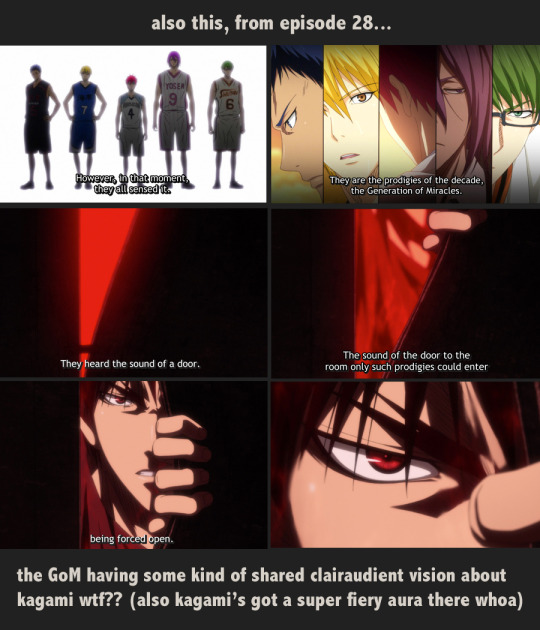
(Subtitles/translation courtesy of Crunchyroll)
… Yeah. I definitely did not come up with the idea to include this stuff on my own. XD (You can interpret these moments as symbolic too… But I feel like the story actually makes more sense if it’s literal, at least on some level? //laughs)
(Especially since that’s not even counting all the aura-like visuals in the show. And the weird eye stuff. And characters who can apparently predict the future in various ways. AND THE TRIPPY DOOR VISIONS AT THE END. SERIOUSLY DO NOT GET ME STARTED ON THE DOOR VISIONS. Anyway.)
On Platform Dining in Kyoto
I might talk about this in more detail for an upcoming chapter, but yes, the part about dining on platforms in Kyoto in the summer is a real thing! You can find a general overview about it here.
Basically, since it gets so hot and humid in the valley where Kyoto is, some of the restaurants have a tradition of putting up special wooden platforms over the river and serving their customers on them. It’s called “kawayuka” dining when it’s done over the Kamogawa river, inside the city. (An area outside Kyoto called Kibune also participates in the tradition, where this style of dining is called “kawadoko.”)
On the Yudofu Restaurant
Finally, in the longstanding tradition of me doing way too much research about the places in my fics, I did indeed pick out a real place for Akashi’s favorite restaurant!
First off, I should probably mention that yudofu isn’t just Akashi’s favorite food. It’s also one of the most famous regional dishes in Kyoto. (Maybe THE most famous!) Kyoto has a ton of restaurants that specialize in making high-quality tofu, so a boiled tofu dish like yudofu is extremely popular, both with locals and tourists. Yudofu itself was also created in Kyoto, because the monks working in the temples needed vegetarian dishes for their Buddhist diet.
Yudofu is thought to have originated in the area around Nanzenji temple. That being the case, I wanted to choose one of the most traditional, famous restaurants there to be Akashi’s favorite. I had a couple of choices, like this restaurant, which is one of the oldest restaurants in Japan. But in the end, I chose a place called Nanzenji Junsei because the atmosphere of the garden, the ability to reserve a private dining room, and the elaborate set meals all struck me as something Akashi and his family would appreciate. (Plus it seems to be highly rated as well as famous.) You can learn about the history of the restaurant, and see tons of pictures of the buildings, garden, and the food on the absolutely gorgeous official website here.
(Yeah. I want to go there. SO BAD. You can also see more pictures of the restaurant in the TripAdvisor reviews, including more shots of the private dining rooms.)
And while I haven’t been lucky enough to try it in Kyoto, I have made yudofu before! It’s an ultra simple dish that relies on the highest possible quality ingredients. So it’s definitely an appropriate choice for Akashi. (That being said, it does amuse me that his favorite food is basically just, well, tofu cooked in water… Like what teenage guy would say that was his top favorite food EVER? Oh, Akashi. You are such a Kyoto boy. XD)
On a side note, if you want an idea of how old some of the restaurants in Kyoto really are, I thought this article of the top ten oldest restaurants in Japan was interesting! Kyoto still has restaurants in operation that date all the way back to the middle ages.
The city’s culinary fame also inspired a longtime headcanon of mine that the Rakuzan players initially bonded over restaurant hopping… So that’s why that keeps popping up in my fics? //laughs Well, that, and this screenshot from one of the third season endings that literally shows them eating together in a place that looks like a Kibune kawadoko restaurant, and wearing yukata no less:
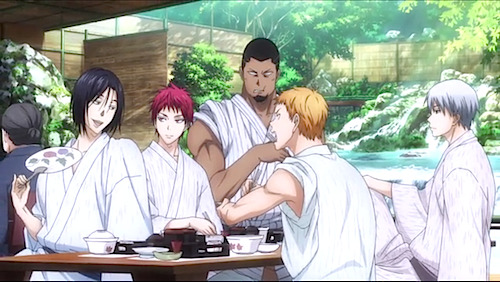
(Oh Mayu, I miss you, why did you have to graduate before this fic takes place? XD)
(And seriously don’t get me started on the shots of each team from that ending, they’re all adorable with great little geographical/cultural references AND I CAN’T)
Well, that’s it for my notes! I have a draft of the next chapter completed, and while my goal is to work ahead in the story first, I hope to be posting it very soon. (I don’t want to give too much away, but I will say… IT’S A TRIP.) I’ll also be sharing my Pinterest board for the fic then, so if you enjoyed the ones for Storming the Castle, that’s coming up!
#long post#really long post#vanishing prince#the vanishing prince#kat writes fanfic#knb fic#kat writes about basketball dorks#kat writes about ADORABLE BOYS AND THEIR ADORABLE FRIENDS HELP ME#I want to go restaurant hopping with Rakuzan XD#actually I just really want to try yudofu in Kyoto#also can I just say I was a mess just from rewatching the few episodes to get those screenshots#I STILL LOVE THIS SHOW SO MUCH#THE EPISODES ARE SO GOOD#I FORGET HOW GOOD THEY ARE SOMETIMES#anyway bless any of you who actually read this#good lord will I ever shut up about these basketball kids#the answer is probably no
16 notes
·
View notes
Text
HoC Onion !

[TW mention of sexual abuse/violence]
I’m foregoing the pros/cons format here but generally-speaking my negative points are still gathered at the top w the highlights near the end.
Obviously, between letting a sex offender have a platform in mass media and potholes, I’d choose the latter. My below crits absolutely are not a demand for Spacey to be brought back and he can die in a fire for all i care. I just wish his character’s absence was not the nº1 reason for this season not making any sense
as far as i can gather, this season’s primary arc is as much about Frank’s death (in lieu of Doug’s) as it is Claire’s emotional and political divorce from Frank while she undergoes your traditional postbreakup analysis of who she was pre Frank and post Frank and were Frank actually there this idea might have legs
...but instead we have Doug ://
the level of intensity that the plot demands cannot be carried by forcing Doug into being a deeper character than he was intended, all the way until the end, he truly just reads as either a pitiful sadist or a henchman. It’s disharmonious and dangerously close to bad.
Frances Underwood makes more sense if Frank dies in episode 8!!!!!!!!!!!!!!!!!! She’s literally going to be his reincarnation!!!!!!!
literally...who cares if Doug gets stabbed by Frank’s letter opener? whomst?
Doug can’t be Frank’s proxy, but sans a certain pedoph*le, the plot will just have to suffer.
Other side effects of Doug’s undeserved promotion include but are not limited to:
forcing Doug to share the role of antagonist with the Shepards, yet another New Villain © that feels totally unnecessary and confusing (the Conways at least got two seasons)
Frank’s diary feels forced and out of character for someone decidedly so unsentimental
How does Claire have a bun in the oven when she clearly didnt sleep with Frank for all of season 5 and locked herself in her room while he was being assassinated? How is a Dramatic paternity test not going to be insisted upon in the show’s universe?
fixation on Frank’s will as a McGuffin is really... I don't know boring considering no one cares for the guy? What property of his does claire stand to lose? I’m sure the rich people fandom can speculate but i honestly needed this manifested in the show via some examples instead of the grand abstraction that is The Will bc losing Frank’s assets would set Claire back but it would not directly threaten her presidency. Not to mention that i’m not entirely sure Frank’d have Doug of all people as his sole heir if it didn't serve as revenge against Claire, which just lowers Doug’s importantance even more
Frank never cared for Doug, a largely unlikeable character, which we already knew from the beginning, so Doug’s entire arc is pathetic at best as well as his tangential inclusion in the Cliare v Frank arc
My major problems with Doug’s character began as early as season 4.
Did not understand why they didn't actually have Doug switch sides by joining the Dunbar campaign in earnest in season 4. Like... it’s such an obvious opportunity to Thicken The Plot © that it’s reached this gif levels of dropping the ball:

P much everything about Doug’s character since then is just so.... lacking, while for the last few seasons they give him depth when he magically has empathy for one (1) woman before she dies (possibly as a direct result of his actions). This entire plot about him evaluating why he was so loyal to Frank could've been unpacked whilst he avoids Dunbar finding out about the murders he did commit. I’d rather him having agency than be a flat, troubled underling.
Aright I'm going to stop complaining about Doug. In season 3 and 4, his insecurity over being replaced and his sacrifices for Frank (and subsequent guilt) came close to giving us a real Moment with him as we delve more into how colourless his life outside of work really is. But beyond that, when his character started getting repetitive, there’s very little to compensate for his alternating acts of extreme narcissism/violence versus his childish confusion / self pity when he doesn’t get what he wants.
Anyways I'm basically at a point where I’d be okay if Frank’s long-lost cousin replaced Doug replacing Frank
I’m appreciating the writers’ distinct refrain from plot formats and that the seasons progressively move towards the Underwoods but what if just for circularity and added balance we return to having a full-on reporter B plot in s6? More emphasis on Janine and Tom’s sleuthing, culminating in Tom’s assassination and Janine publishing the tell-all expose against Frank---including a reference to Zoe---that becomes the magnum opus of her career (and Claire using that against Frank). I just think the season needed more balance that Doug, the Shepards and Tom were not offering
The Shepards and Tom, meanwhile, are decidedly banal. First of all, I had a hard time even telling Bill and Tom apart esp given that they were introduced one after the other. All white guys are the same.
Bill just kind of sits around until he has a platform to reference his favourite action movies doesn't he?
Moreover what does Tom do!? he doesn't want power, he doesnt seem to want anything. He’s just kind of there?
Unlike the Conways, the Shepards don’t have a clear goal and are not often in direct conflict with Claire the way Frank and Conway were. They want to control the presidency for money and Claire is always bouncing back from reliving her girlhood to political rivalry w Anette, yes, but what does that mean? What are the consequences? The logistics are so indirect and complicated, what precisely does Anette want? And why does anyone care? The Shepards are extremely boring.
Frank’s asides were purple and long af so I appreciate Claire’s succinct style not to mention her fantastic screen presence. I’m left to wonder, though, if maybe hers and every other aside in HoC is a little too on the nose. Like, they didn't hafta spell it out that the bird in the wall was a representation of Frank’s shadow trapping her, I think we got that
The artistic intercuts to Claire’s troubled childhood wherein a group of bullies coerce her into stripping naked through the forest, while visually stunning and clever for its self-explanatory nature, feel really passive. They don't visually show us any reason for her not to resist, the bullies even let her keep her clothes after cutting them off her so we’re left to wonder why she does nothing....
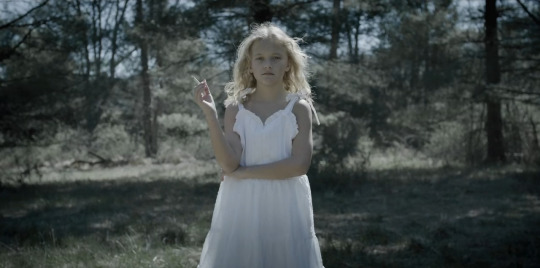
Claire was raised to be ~proper~ so her resistance (likely) comes in the form of biting, passive-aggressive poise which is hard to get across in a silent montage but it just feels.. weird
Frances Underwood is going to have a very sad childhood
nearly all the Claire flashbacks are cinematic masterpieces and as much i think Claire’s backstory deserves more attention, i also appreciate the minimalism and the choice humanising moments of her adolescence
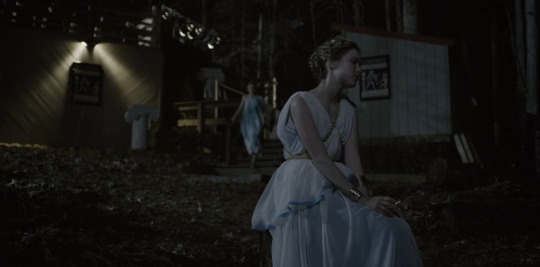
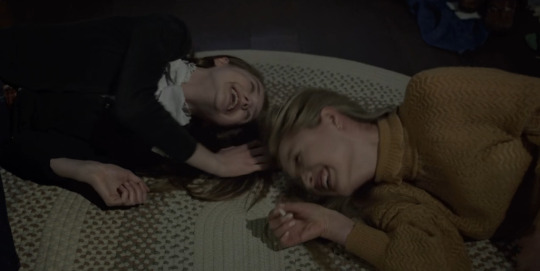
listen I'm sure we all agree Robin Wright is peak acting but the actor for young Claire, who has the arguably harder task of copying Wright is fantastic
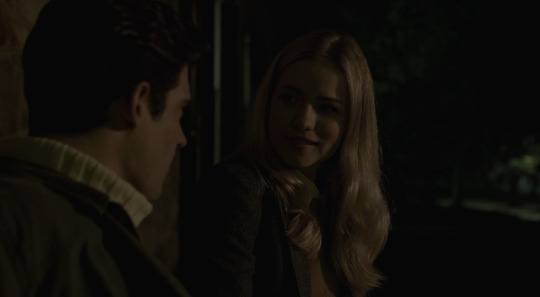
Of all the characters who crop up every season seemingly out of nowhere only to disappear once more once when the plot the Underwoods are done with them, Jane is one of my favourites and possibly one of the greyest characters alive. Smart, mysterious, worldly, a bit of a hippie despite her job, severe despite her sense of humour. Really loves her extremely pedestrian surname. We stan.
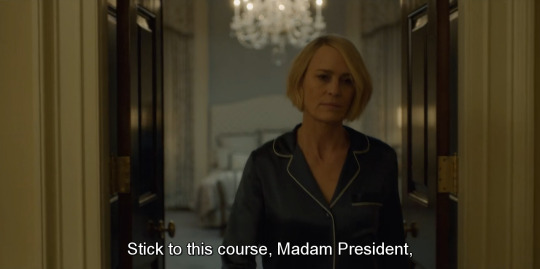
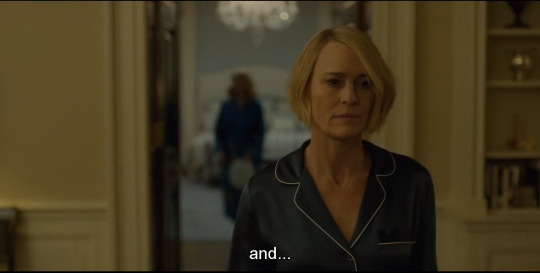
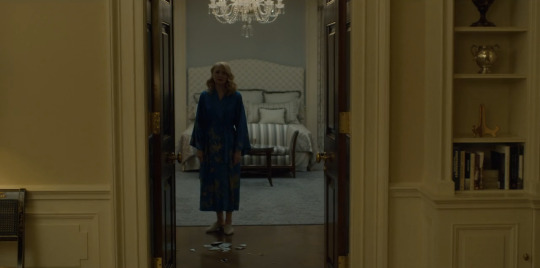
Secondary characters rarely get anything close to a backstory on this show, esp ones that were introduced so late. Still, her motivations seem more complicated then others (i.e. betraying Cathy, one of two people she cares about) and I wonder if they deserve a bit more of an explanation. Especially seeing as she has a relationship with every major character.
If anyone deserves a spin-off it might be Jane and her name-dropping career/social life
Cathy faking her own death with a terrible french accent? On stan !!!
Seth teasing Doug even while he’s completely undervalued by everyone around him is a power move
Impressed that they managed three characters named Tom, their distinctly different appearances and the fact that they're almost never in the same POV shots works to separate them.
Claire using the word “female” even facetiously is cringe
Whenever they use the cinema room, the movie they watch is always symbolic. Before the 2017 election, Frank and Claire imitate the characters in Double Indemnity, and this season a pregnant claire watches Rosemary’s Baby. Clever.
i liked the whitehouse tour guide’s inclusion and the cameo from _____ though this season was especially white without their usual token secondary character
So overall i liked season 6 as an exploration of Claire’s character even while it did v little justice to most of the other characters and unfortunately spacey’s absence did affect the storyline
and finally: that cinnamontography !
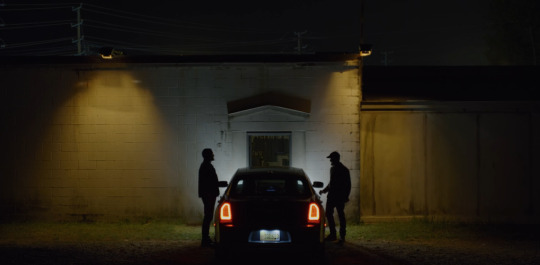
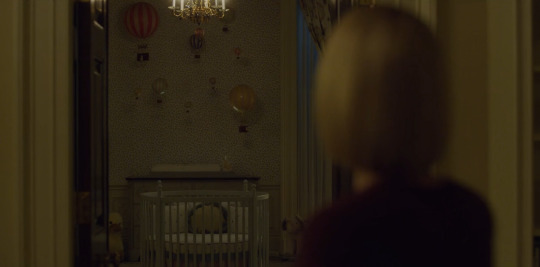
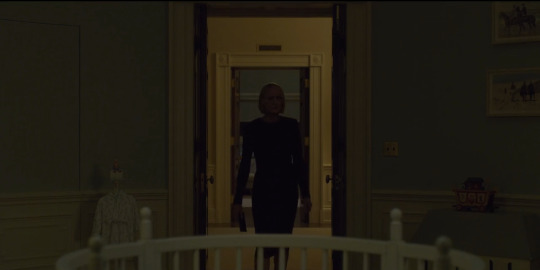
Not that the series should be pushed past its prime, but wouldn’t it be interesting to see Claire as a mother?
#hoc#house of cards#robin wright#claire underwood#hoc season 6#house of cards season 6#u#c#onion post
13 notes
·
View notes
Text
SPOILERS First reaction to Star Trek Discovery: The Butcher’s Knife Cares not for the Lamb’s Cry (S01E04)
Hmm...well...this is just my first watch mind you, I may have a different reaction after I rewatch it. Suffice to say, I was less impressed with this episode. Personal rating? 3 out of 5, with acting, set design and visuals saving it, wasn’t happy with the writing.
Under a cut for spoilers.
I’m glad that Lorca’s weapons room is actually accessible by anyone on the ship hahaha. The idea that this was a secret room kind of intrigued me but also bothered me. How convenient that it has one containment field though.
This episode has less to do with characters (except for Michael, Kol and L’Rell, they do get some kind of character development) and more with the other ‘mysterious’ operations on board Discovery. We get to see the saucer spinning in an awesome way when the spores are used for the first (unsuccessful) jump. I love having a Star Trek with a budget and today’s CG!
As for the rest of the episode...that was a fascinating beginning, making us think that we were seeing an alien world or some weapon being charged...only to see that it was the internal workings of a synthesizer making a new uniform. I suppose it was foreshadowing for what was to come - that the “monster” on board was not actually a “monster”, but a dust mite gone giant. And when you’re that small, even the mundane appears like a whole galaxy.
I think this is part of Discovery’s theme, or whatever they’re working up to - we got those Alice in Wonderland references in the previous episode of going down the rabbit hole, up is down and down is up. Let’s also remember that Alice grows large or tiny in a mysterious world. We’re told about spores that connect the entire universe to each other - a universe in a drop of sand, a key with each spore. It’s kind of a good idea actually, that while we are fascinated by space and in love with the view of a binary star system (or just in love with the view of space), we have to remember the tiny blocks that make it up. Maybe space is not actually the final frontier, it’s simply the frontier we can’t turn away from...but can’t understand either without looking at the tiny alien worlds making up everything around us.
Landry’s death was a waste, and I say this even as a Game of Thrones fan. I suppose it’s a death to prove a point, that no character is safe, that anyone could drop at any time. However, I don’t feel invested in her death. When GoT “suddenly” kills people, there’s generally a consequence to their death. I mean, I get the first major death. Philippa is kind of like the Ned Stark of the show - her death and gruesome post-treatment will have repercussions throughout the entire series. She is the traditional Starfleet Captain everyone wished we’d get on Discovery, and her death was symbolic of the effort to bring Star Trek into a new age...but her memory is also symbolic of the show trying to keep to that foundation, that no matter how far they seem to go, they remember what the base is supposed to be. Landry’s death however, appears rushed, out of character (how can a Head of Security be so stupid and impatient?) and her death doesn’t really have any repercussions to the story because she hasn’t been a character for that long. I mean yes, Discovery needs a new head of security, it will likely be another tough talking security person who worships Lorca. With Discovery’s mandate and command structure, it is unlikely that anyone Lorca doesn’t know/approve of would take over the position.
I was proven wrong about Saru’s threat ganglia. I thought they appeared because Lorca beamed the creature on board Discovery, but no as it turns out, it was because of Burnham after all. I wonder how those threat ganglia work - are they out when Saru feels like there is a threat nearby, or out when there is an actual threat? It seems like the latter since Michael used Saru to test the creature’s threat level, but if that’s the case, it really does mean that Michael is a danger to the ship.
That’s very interesting. It was interesting to see that they need to further erode Michael’s relationships with Saru on board the new ship. I feel like her logic in this episode wasn’t fully thought out - she’s new to the ship, she respects Saru, wouldn’t it make sense to cultivate a long-term relationship rather than use him to figure out a short-term mystery? (Whether the creature is a predator or not). I know that logic when it comes to things such as human relationships is a tough thing to conclusively nail down, maybe she knows him well enough to know that there’s nothing she could to now to conclusively tip his opinion of her one way or the other? Again, hard to say, only four episodes in.
Sometimes the problem with establishing a character who is supposed to be brilliant in the way Michael is, is that you really have to trust the writers to match up. This is less of a risk in an ensemble cast where other characters with different strengths can take the limelight, but in a show where this very brilliant character carries the whole thing? I suppose that’s why we see the conflict between emotion and logic in Michael, and her childhood trauma explains why it’s a little out of whack but still...there are counselors in Starfleet Medical. There’s no good reason why Michael isn’t talking to one. Heck, the counselor is a beloved Trek character-type - Troi and Dax? We can’t be an enlightened future civilization without appreciating how much we need them, especially since this is wartime. Again, only four episodes in.
As for Kol and L’Rell, we’re still seeing how their story will develop (more Kol than L’Rell). Kol is Michael’s foil - a Klingon raised on the fringe of society who has lost his Leader and is desperately trying to understand and preserve that Leader’s legacy. They’re both trying to claw their way back into a position of influence, they both have missions. I have no darn clue what Kol is going to do, but the obvious parallels points to something huge. I’m intrigued about Kol having to give up ‘everything’. Arguably, Michael has already lost everything, and Kol has lost most things. But I’m also interested if he’s going to be changed in a way that will ... perhaps... take us on the path towards the Klingon appearance we are more familiar with?????? Da da dum!
That’s my tinfoil of the day.
Overall, another big setup episode. It was a joy to see the creature (Ripper) toying with the spore forest, and sad to see how much agony it goes through with each jump (seriously Starfleet? You haven’t figured this out yet? If you think Ripper is an alien creature, you are literally torturing a creature that is from an unknown planet or source!! You’ve established it is sentient! WTF ARE YOU DOING?!!!...I guess the alternative was not rescuing those miners, and Lorca is a crazypants, but still, you had Michael give Lorca a huge speech about living and dying by the ideals of the Federation in the previous episode and now we have this??? Writers....you can do better. You honestly can do better). I really liked seeing the saucers spin before the jump.
I’m not satisfied with the fact that Discovery didn’t actually help those miners. They left them abandoned in a mining facility with no defenses and barely any materials left, no medical attention...nothing really. The next Starfleet ship is about 80 hours away now, that’s presuming they are sent to help the miners, and also presuming that any Klingon force is even further away (they sent an attack that is no unresponsive, they are smart enough to send at least a ship out there to figure out what happened to their missing ships). And since those miners don’t know it was Discovery that saved them, wouldn’t they be a little harsh on Starfleet? Well, I suppose we will see if episode five will address any of these thoughts.
Overall episode four is my least favorite episode out of what we have so far. But you know what? It’s just one episode. We have a season to get through.
(My favorite episodes, ranked - 3, 2, 1, 4).
1 note
·
View note
Text
User Experience In India And Its Many Interfaces
Design is a tool to simplify tasks. It is a weapon to defeat society’s challenges.
Design is both the answer and the question. Design exists in a plethora of areas from industrial (cars, machinery, furniture) to art (logos, magazines, paintings) to photography, to anything you name. And, ever since we touched technology, the design started to play an even bigger role.
In recent years, global companies started to focus on creating better digital experiences that efficiently communicate and engage with their users effectively through their websites, mobile apps, user interfaces, and product sites. Because 88% of online consumers are less likely to return to a site after a bad experience.
Statistics show that first impressions are 94% design-related. This only goes to say why Digital User Experience is booming across nations and industries. But how far is India in this UX game? Are Indian companies welcoming the changed perspective about customer experience? Does it seem promising to invest in a good UX studio? Read on to find out…

Who is who? Breaking down the roles of UI & UX design
To understand tech design in its true sense, let’s turn to the father of innovation – Steve Jobs, “Design is not just what it looks like and feels like. Design is how it works.
The way in which we connect with any product is by pure experience design. Take Facebook, Instagram or Twitter, for example, these are social networking products that we intuitively interact with every day.
Right from effortlessly scrolling through the organized feeds to instantly checking your notifications, from uploading multiple pictures or videos to adding filters, every step of that experience is designed by ‘User Experience Designers’ and ‘User Interface Designers’.
UX designers are responsible for ‘how a product feels’, ‘how a product effortlessly flows from one step to the next’, ‘how one interacts with the product logically & intuitively’ and ultimately makes the users ‘fall in love’ with the overall experience.
“It is not enough that we build products that function, that are understandable and usable, we also need to build products that bring joy and excitement, pleasure and fun, and, yes, beauty to people’s lives.” – Don Norman, author of The Design of Everyday Things.
UI designers are responsible for ‘how the product is laid out’, ‘how each screen or page looks’ and consequently take charge of ‘how the overall product is visually capturing and communicating what the UX designer has charted out’.
UX or UI designers are not the same but many companies have started to merge the roles as they weave their responsibilities into each other. ‘Do me a favor. Kill the term UX/UI’ is an eye-opening article that will help you understand how the two roles are different with a fine line running between them.
The stages of creating a better user experience
An integral part of helping UI & UX designers create magic is Usability Testing.
The tests help understand a user’s behavior, collect both quantitative & qualitative data, evaluate the user journeys by testing it with representative users and also explore several unique design approaches to solve a specific user problem.
An effective Usability Testing ensures optimum customer engagement and helps businesses create the best customer experience for their products. It’s not surprising that 86% of client-side marketers use or plan to use usability testing to improve their conversion rates.
Understanding the journey of UX/UI is the first step to choosing a good UX partner.
For example, this is the basic process involved in creating a beautiful website experience:
User Research: To understand user needs, behaviors, perspectives and empathize with the user. Collecting data from a significant portion of people in the real world rather than a generic everybody.
Site Structure: Gamut of information broken into logical parts, simplifying navigation and bringing clarity into the big picture.
Wireframe: Ideas are gathered into a concrete form, a skeletal framework is charted out with intuitive interactions, relevant feedback is incorporated.
Mood Board: Arranging images, references, styles, colors, and fonts in line with the overall brand/product personality and emotion.
Visual Design: Pushing the pixel through a lot of refining, iterations and capturing a true visual experience for the brand.
Usability Testing: Finally, the hour of truth through testing on actual users, iteration, modifying and creating the ‘best’ website experience.
The whole process dovetails design, efficiency, effectiveness, simplicity, innovation, and technology. Statistics show that judgments on website credibility are 75% based on a website’s overall aesthetics in addition to its functionality.
The next time you book movie tickets or shop online, pay attention to the details of how your experience changes from one brand interface to the other. Now, that’s your hand-on-course on user experience.
Now that you’ve got a hang of what UX/UI deals with, you might be interested in knowing how Apple made ‘Your face the interface’ for its new iPhone X.
Craving for more? See the world’s most important interfaces of 2017.
Riding the global wave of experience design
Several companies across the world are embracing the significance of having a dedicated UI/UX designer working with them. This, in turn, is causing a wave of growth to lash onto the user experience communities, globally.
The UX market, from the perspective of both the customers and clients, is booming as people realize the bounty of business benefits they offer. Did you know that the revenues of ESPN.com jumped 35% after they listened to their audience and tweaked their homepage?
Every company or brand seeks to receive valuable business solutions that assure great returns. They expect the UX designers to not just provide solutions but add value to their business that turns into profits.
For these reasons, the need for a dedicated usability testing lab is crucial but most companies prefer to outsource the same to get unbiased results.
Understanding user behavior
Good UX services demand both time and money to be invested by the clients for the initial User Research. This research would tackle the primary twin-question – ‘Who are our users?’ & ‘What do our users want?’ before jumping into design recommendations.
Because the underlying goal of any user experience practice is to understand the user better and deliver intuitive solutions that satisfy their needs in every digital window they use. Studies show that 90% of people use multiple screens sequentially and 85% of adults think that a company’s mobile website should be as good or better than their desktop website.
For example, the popular brand Fitbit has a mobile app that connects with its fitness trackers to enable its users to keep track of their fitness levels. Their mission is to get people moving, a herculean task which can be achieved only by changing a person’s habit. Here’s a detailed study on the UX of Fitbit conducted by Stacey Wang, a product designer.
While we are on the discussion of mobile user interfaces, it’s crucial to note that mobile users in India are growing, thanks to increased and improved mobile content. Read this Nielson case study on Mobile User Behaviour in India to understand the scenario better.
“Asking users to adopt new behaviors or even modify their existing behaviors is very, very hard.” – Khoi Vin, Principal Designer at Adobe
Nurturing the UX/UI future: Will India dance to the demands?
With clients and customers both demanding brilliant brand engagement, UX/UI design roles will always be in demand. There are many specialized UX studios cropping up in the country every day that deliver customized customer experience solutions to every kind of client.
On the other hand, IT companies in India are integrating their software-development lifecycle with UX services. But there are many more who create a niche space for themselves in the market by specializing in specific usability services. Few top services include:
User Research
Heuristic Evaluation
Ethnographic Studies
Info Architecture
Wireframing
Visual Design
Front-end Developing
Product Design
The future of UX in India looks sharp, no doubt! India being a developing nation with a plethora of businesses cropping up in the blink of an eye, creating products specifically for the Indian market is a new ball game.
It requires a broad and narrow understanding of Indian users and their local perspectives. The main reason why many companies are investing in UX partners who understand the Indian culture and deliver unmatched experience design that is both pleasurable and profitable.
That said, the nascent UX scenario in the country needs a lot of TLC (Training, Learning & Cultivation) which is why employers and UX professionals should help the fraternity to grow through seminars, workshops, domain specialization, educative sessions, interviews, discussions, global connections and sharing knowledge.
The UX market in India will continue to expand as more and more customer-experience benefits spring up. You will be surprised to know that India is yet to discover the massive untapped potential in the UX realm, especially in finance, product design and legacy software.
So, the next time you visit Amazon or Myntra or any website, spend a few more minutes observing why pop-ups pop up at a certain place or why the product pictures attract you the way they do or why do some sections appear highlighted than the others or why you keep falling in love with only some brands and not all!
Finally, we’ve found ‘x’ and the answer to the problem is UX!
At Thence (Winktales), we apply research-driven processes and frameworks to design and better the user experience of your products. We approach design with the user at the heart and work for the future.
Here you’ll get to know more about our User Experience Services or you can write to us at [email protected]
Originally published on thence.co
0 notes
Text
REVIEW - WONDER WOMAN
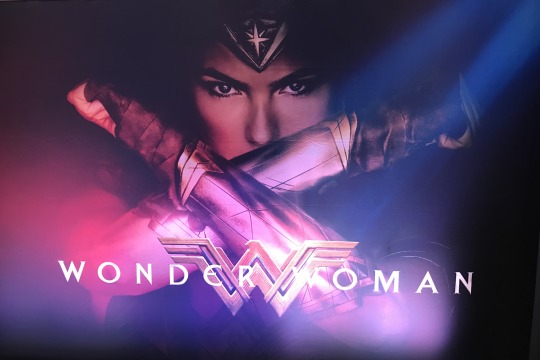
I absolutely love it when a movie meets my expectations. For years I’ve been looking forward to the Wonder Woman film. It did not disappoint. I would go so far as to say, it is the best superhero film I’ve ever seen. Definitely part of the top 10 films I’ve ever seen. I loved this film. Between the humour, action and notes reflecting on history, we as an audience were taken in. Director Patty Jenkins is a genius and credit to her craft, in my opinion she has created a world that surpasses the stories previously told in the superhero universe.
The audience was captured by top notch storytelling. Both in the flow of the story and the performances on screen. For years we’ve been waiting for a solo story to be told on the scale of a full on blockbuster epic. Wonder Woman meets that criteria. There are elements of a 300 meets Captain America way of storytelling. I say Captain America because that is the best Marvel solo story and 300 because of the action sequences combined with the flow of the story, completely reminiscent in Wonder Woman, but on a higher scale.
Gal Gadot absolutely encapsulates Wonder Woman. Like I’ve said before in my Suicide Squad review discussing Margot Robbie as Harley Quinn, I’m finding it hard to imagine someone else in to role of Diana. Gal Gadot is absolute perfection. She has the emotion, characteristics, mannerisms, everything down pat. I think it helps Gadot has skills when it comes to fight sequences. Her movement is absolutely amazing. That combined with brilliant camera work and directing, create scenes that make me think, I’m taking this to my gym and I will transform. Like I felt when I was a child, I want to be Wonder Woman. It’s been a while since I left the cinema thinking, I want to be that character. A while since I left the cinema feeling invigorated, as if a part of that character imprinted on me. That was the case with Wonder Woman.
Chris Pine as Steve Trevor one of my new favourite characters of all time. His interaction with Wonder Woman and his overall being really resonated with the audience. He was us, the person coming in to this new situation and explaining the realities of life. There were some really funny and lovely scenes between Steve and Diana. The way this relationship grows over the film is a testament to the writers and their delivery in storytelling, having a friendship like that grow in amongst the other stories, all the while not distracting us from the other plot lines is pure genius. The bathing scene is so well done, and helps establish the tone in their story. The growth in all the characters is so well achieved too. You come to love these characters and can’t wait to see what happens next.
Lucy Davis as Etta Candy is another new favourite character. If we were like any character in this film, we would definitely be Etta Candy. She’s the one that brings grounding to every situation. She is hilarious, bringing a light, fun hearted quality to the film. What she brings to the story, just adds to the overall appeal of the film. She’s fun and quirky, so the humour she brings to the story is honestly a breath of fresh air. It’s the type of humour that is more a comment on a situation in passing that has a really honest element to it. Her relationship with both Steve and Diana really makes her a loveable character. For that matter, I really like the use of love, or more so the idea of love in this film. How it relates to the start, middle and ending of this particular chapter. Almost like a thread that connects the different plotlines, and emotions in each of these scenes, together. Another notable mention, David Thewlis (who you may remember as Harry Potter’s beloved, Professor Lupin) stars as Sir Patrick, someone who is instrumental in the going ons of the war, he funds the mission for Diana and Steve to stop Doctor Poison. It was interesting to see Thewlis take on this character, in contrast to characters he’s played in the past. There’s dimension to his character and ultimately the delivery of his role throughout the film really adds another layer to the story in itself. Especially when it comes to his interaction with the team and that includes Etta.
Another great element to this film was the team Diana and Steve formed, Charlie (Ewan Bremner), Sameer (Saïd Taghmaoui) and Chief (Eugene Brave Rock). We start the film off with Diana in present day, receiving something from Bruce Wayne aka Batman. That package is a photo of Diana’s team. The letter reads, I’d love to know the story, it is this device that launches Diana into the telling of said story. Our beginning, and ultimately her origins story. I’ve said it before and I’ll say it again, it is the best origin story I’ve seen yet. You go on such an amazing journey over the two hours of this film. Each part contributes to the story, it adds to the development of not just the plot but the characters. Starting off Diana is a tad unsettled by her team members as they don’t show to have the particular values she shares, but over time Diana learns you can’t judge from first impressions. Underneath each person there’s something that has made them who they are standing in front of you. With each experience you are shaped into the person you are. That photo represents that.
There was a point during one of the action sequences where I was brimming, smiling like a cheshire cat. I was elated to see a character I’ve looked up to for decades, become a role model to a whole new generation. Add to that how amazing the action sequences were. The slow motion coupled with the amazing moves really created a feast for the eyes. This was also achieved in the training fight sequences. The Amazons on the island of Themyscira created such a cool dynamic of training and then ultimately fighting. There was a good mix between the action and story in this part too. Learning about the history and how it relates to Diana’s story, and how she then takes that mantle on to bridge that into the larger picture of the film. Connie Nielsen and Robin Wright are great both in the way they took on the roles of Queen Hippolyta (Nielsen) and General Antiope (Wright). I honestly want to be a mix between the two, particularly because both have a different type of strength. A strength that can be seen in Diana. You can see over the course of the film that Diana was given the correct arsenal of strength thanks to these two ladies. Over the course of the film with every person she meets, she gains something new, particularly understanding and a new scope on the greater meaning of the world.
Ares God of War is the villain in this film. A being whom Wonder Woman sees as the catalyst for the current World War, the main reason she has journeyed beyond the seas of Themyscira to save the World. Diana believes Ares has corrupted the minds of men and is the sole cause of the World War. That he has taken on a role within the high ranks of military to influence a nation. General Erich Ludendorff (Danny Huston) fits this bill and Maru aka Doctor Poison (Elena Anaya) is by his side creating a gas that will assist their goals. Both are a different type of villain. That’s the thing with the DC villains, two different villains may have the same goal but they each achieve it differently, in their own style. Again, a varying male – female villain duo with their own style. There are some epic fight scenes throughout and the visuals are brilliant. At one point Steve Trevor infiltrates their camp site and upon escaping, nonchalantly drops a hand bomb into a space. The visual effects in the blasts and fire work within the film are so well done. Overall the special effects were above average in Wonder Woman. There were two moments where I felt some of the imagery looked a tad blurred, particularly when it came to panning in moments that were at times moving fast, but ultimately those small problems paid no consequence to the whole aspect of the film. The costume design is Oscar worthy. Between the outfit Diana wears in the present (I want that outfit), to her Wonder Woman warrior outfit, to her London style, the fashion in this film was beautiful. I loved Etta’s outfits too. That’s the thing, each character had an outfit that was specifically designed to represent the persona and how they relate to the situation they’re in. The hair and makeup complimented these looks, especially the hair. A lot of what I saw in the film could translate into every day life (just my excuse to look like Wonder Woman every day), between the gladiator sandals, to the royal blues and reds, along with the gold, I’m pretty sure I’ll be re-organising my wardrobe this weekend. Speaking of colours, the cinematography in this film is stunning. The contrast between the rich colours in Themyscira to the dull colours of London was achieved well, and summed up perfectly by Diana. I have to also mention how brilliant the music in the film complimented scenes. The Wonder Woman theme playing as she broke through a window in slow motion to then launch into one of the most epic fight sequences was so brilliantly done. I could not stop smiling. Overall it’s a complex story, with complex characters that create a fantastic story, that audiences can respond to. It’s the first superhero film directed by a woman, Patty Jenkins, a director who has created cinematic brilliance. It’s truly inspiring, both in how this story was achieved/delivered and the content created. It’s very rare that I come across a film that I love this much. That gives me different levels of feeling and emotion using a variety of techniques, like humour, heart and action. Which is why I rate this film 5 stars. I will definitely watch this film again. Walking out of the theatre I was asked, “how was it?” (I was wearing a Wonder Woman top, grinning and enthusiastically analysing the film with my colleague. I replies, “It’s honestly the best, the best superhero film I’ve seen.
Rating: 5/5
☆☆☆☆☆
#Wonder Woman#Wonder Woman Movie#Wonder Woman Review#Wonder Woman Movie Review#Gal Gadot#Chris Pine#Patty Jenkins#Margot Robbie#Harley Quinn#Diana Prince#Steve Trevor#Lucy Davis#Etta Candy#David Thewlis#Ewan Bremner#Saïd Taghmaoui#Eugene Brave Rock#Bruce Wayne#Batman#Themyscira#Connie Nielsen#Robin Wright#Danny Huston#Elena Anaya#DC Comics#Queen Hippolyta#General Antiope#Movie#Movies#Film
8 notes
·
View notes
Text
Erasing the Stigma: Fanfiction as Legitimate Form of Literature
Remember this post from a few weeks ago that got a ton of notes (which I am STOKED about)? Well...I just submitted the final draft!! I figured you guys would want to see what your responses amounted to so here it is!! If you’d like to share it with others (especially those who look down at fanfiction) go ahead!! I’d love to spread the word more~~
(Oh! and here is where you can access the original formatted with the works cited essay)
Erasing the Stigma: Fanfiction as Legitimate Form of Literature
Two writers type on a desktop computer. One sits cross-legged in a dark room lit only by a single, smooth Mac surrounded by sheets of character references, thesauruses, dictionaries, and the occasional motivational quote. The other in a similar position but at their local Panera with nothing but their school laptop open to a few wikis, Thesaurus.com, and maybe some calming music. Both bite their lip as the words fail to transfer to screen. Both stress about the possible response to their pieces. A few hours later and they are ready to submit. The first contacts their agent who then contacts a few others. Days, weeks, months pass and the first writer still hasn’t heard back from their agent. The second author uploads their file as soon as they finish typing the last word, sometimes in an email to their beta (or their editor from the same fan-base), other times directly to the site. Days, weeks, months pass and the second author has already cranked out more chapters, received a handful of reviews, and has gained many followers. The difference? The second person uploaded theirs to Fanfiction.net and is looked down upon by most of society. There has often been a stigma associated with the term “fanfiction”, as if it was a disease or something others look down upon. Yet many see it as a creative outlet and something that allows them to fully express themselves in a way that formal writing or writing a physical book cannot. Some oppose the fact that fanfiction, stories written about video games, movies, television shows, etc., are forms of literature and say that reading and writing is not “real” reading or writing. They even may go as far to say that fanfics serve no outside purpose and has no content. While some stories may be lacking in the grammatical or logical correctness, fanfiction as a whole is in fact a valid form of literature, especially when compared to formal reading and writing.
In order to discuss fanfiction, it needs to be defined. Fanfics are stories that are written by fans of a certain form of entertainment (whether that be musicals, books, animes, television shows, movies, etc.)(Lammers and Marsh). Fanfic authors are not paid, do not expect anything in return (except for the occasional review or two), and write just because they like the show and have an appreciation for writing. The fanfic author, formerly known as epeolatryx on Tumblr, writes, “People don’t pay for fanfiction. Reviews are our currency. Thank yous pay for the effort we spend on the next one,” (Xambedo). Another difference comes in the form of creativity, or rather, starting with nothing versus starting with a pre-existing base. Instead of creating entirely new universes with brand new characters, fanfic authors use existing characters, settings, and plots from existing medias to generate their own stories. Some of these stories even become so popular that they end up published due to a uniqueness they had despite being based on something else. The After series by Anna Todd, a One Direction fanfic, began on Wattpad, a free, digital publishing service, and became a published novel that is going to be made into a movie (Contrera). Granted, Todd had to change the names of the band mates in order to avoid copyright infringement but this successful story still began as fanfiction. Other fanfictions include The Little Mermaid, The Lion King, Ella Enchanted, and many more that do not seem obvious to the naked eye. The only difference between stories on sites like Fanfiction.net and the ones listed above are that the second are considered “actual books” or “real reading” whereas the first are not. It all comes down to what makes up real literature.
Literature is defined as “any piece of writing that can claim that it has—in some way—artistic beauty” according to Richard Jewell, author of Experiencing the Humanities. However, he later states that items such as bullet points and grocery lists would not count as they are not artistic and are only meant to serve as lists rather than actual pieces. In his textbook, he states all of the qualities that make literature and claims that if a piece were to include those attributes, that it would be considered literature. Those three attributes are creative description, characters, and plot (Jewell). All of those are included in fanfiction which are just stories created using non-original characters. Based on these requirements, fanfiction would factually be regarded as literature. Not only does fanfiction count technically as literature, but the process is the same.
Fanfiction should also be viewed through a newer learning term known as the multiliteracy framework. Multiliteracies are forms of reading or writing that incorporate more than just a pen and an idea; they explain how different cultural mediums, forms of communication, and compositional variety come together to create a piece (Chandler-Olcott and Mahar 559). Three main branches of this framework can specifically be applied to fanfiction: multimodality, intertextuality, and hybridity.
Multimodality involves the “integration of various Designs such as visual, linguistic, and audio in one text…” (Chandler-Olcott and Mahar 561). In regards to fanfiction, authors often employ these three attributes in order to entertain their readers and make their story more enjoyable. In my experience as a fanfic writer and reader, we authors show pictures or fanarts that we have created or have had created for us, find music or sound effects to serve as the background to our stories, and alter their fonts to evoke a stronger meaning (such as italicizing thoughts). By doing so, we are incorporating many different elements into one to create a diverse and interesting final product.
The second concept is that of intertextuality. Intertextuality are the “relationships and references between and among texts. Fanfiction is the crossing of original ideas with those of pre-existing characters and features which, in a sense, is exactly what intertextuality is. The connection between two sources doesn’t have to be strictly between two written pieces; Chandler-Olcott and Mahar explain that it can also occur between fanfiction and reality. The authors describe a fanfic the girls they studied wrote that involved deep, psychological questions such as a woman’s place in the world and heterosexual relationships despite the girls still being in middle school. The authors say, “Viewing rhetorical moves like these from the perspective of the Multiliteracies framework helped us to appreciate how complicated, and even sophisticated, the girls’ fanfics often were,” (Chandler-Olcott and Mahar 563). The two fanfic authors were able to pull from different forms of “text” in order to create a unique and thought provoking piece by using the concept of intertextuality.
Finally, hybridity is the creation of new ideas by picking and choosing specific parts of different mediums and combining them in a unique and sometimes never before seen way. Fanfics tend to grab from many different areas such as different genres and different story structures. When I go to publish a work of mine on Fanfiction.net, it prompts me to select two different genres before I can continue. Much like published books, fanfictions mix many genres together such as adventure, romance, comedy, etc. in order to create a successful and unique piece. However, fanfictions differ from books immensely when it comes to story structure. In fanfics, there tends to be a lack of an exposition or any explanation, description, or background of the story; the author jumps right in (Chandler-Olcott and Mahar 564). Fanfic authors choose to not add an exposition because they know that their audience knows almost everything about their characters: their physical attributes, their history, their personalities, their hopes and fears (Chandler-Olcott and Mahar 564). By neglecting to include an intro and picking multiple genres with which to base their stories on, fanfic authors rely very heavily on the concept of hybridity. Creating a hybrid of literature tends to have consequences, though not the ones that society may expect.
Fanfictions are a new branch of reading and writing that not only counts structurally, subjectively, and scholarly as a form of literature but also, much like its published counterparts, leaves an impression. In my survey of over two-hundred people, I found that around 53.59% of respondents had connected with new people they otherwise would not have met through fanfiction, whether it was reading or writing. This is due to the collaboration and connection with authors and readers via the follow, favorite, review or comment ability on Fanfiction.net that allows people to say how a certain chapter made them feel, make assumptions on future chapters, and offer suggestions for future chapters. Social media also plays a role in connecting readers and writers. On the popular social media site, Tumblr, many fanfic authors publish their stories in order to further spread their work across their fandoms (or domains in which fans from the same genre congregate). This allows the fan-base to actually contact the author on a more personal level rather than just via the comment section.
In addition, fanfiction affect the connection between each other but it also changes one’s reading and writing habits. Motoko Rich’s claim that student standardized reading scores have steadily declined due to online reading (Rich 1). However, measuring one’s aptitude for test taking does not translate to their inclination towards reading. A psychology professor at Michigan State, Linda A. Jackson, agrees when talking about the results of giving low income students internet access: “[The students] were kids who would typically not be reading in their free time… Once they’re on the Internet, they’re reading,” (qtd. in Rich). I have also found that fanfiction actually increases a reader's want to read by means of the survey I conducted. 75.95% of respondents say that they are more motivated to read fanfiction than actual books, which in turn makes it easier for them to read more.“Books are a big time commitment for something I might not like. With fanfiction, I get something I’m already familiar with and will know I’ll enjoy, and they’re much shorter,” said a respondent to my survey. This is because in published works, the author has to include an exposition where they describe the characters and setting. In fanfiction, since it’s based on a world that already exists, the readers already know what the characters and setting look like so the author can jump right into writing their story. Reading online not only increases one’s wish to read, but also improves their writing as well. According to the study done by Jayne C. Lammers and Valerie L. Marsh titled “Going Public”, the young author they had longitudinally studied said that fanfiction had allowed her to stay anonymous and therefore felt more willing to share her works with others than if they had known who she was (Lammers and Marsh 281). By being anonymous, fanfic authors are able to express themselves and produce pieces that they otherwise may not have shared which allows them to further grow as a writer. A fanfiction writer who took my survey said the following:
Real writing, to me, is writing that makes us grow both as readers and writers. When I first started writing, it was through fanfiction. I was horrid at first. But fanfiction gave me a supportive, eager community to be able to continue producing work and subsequently grow into the writer that I am today. Therefore, I can confidently say that fanfiction is a valid alternative to reading and writing.
With the practice of writing fanfiction and support of the community, this author was able to make a name for themselves and eventually grow into the writer as seen above. A writer that may either turn into a published author or a fanfiction author.
19 notes
·
View notes
Text
UNLIMITED COINS GLITCH UPDATE - MADDEN MOBILE 17 - COIN HACK (MAKE BILLIONS)
Free Article Spinner Online - No Sign Up Needed! Madden Mobile Hack And Cheats Now Get Your Cost-free Coins Cash Madden mobile hack and cheats had been developed by a group of men and women who wanted to have indefinite coins and cash in the game, if you use them in your game play it's a matter of few actions and you will be leveling up with out getting any in app currency. Becoming a mobile version of the Madden Ultimate Team, madden mobile NFL comes with all players as well as all the needed cards. Stop Mobile Quarterback - In order to cease the mobile quarterback, you want to choose the defense formation of 4 defenders on the line. Seasoned players of this on-line multiplayer game nowadays make use of this hack tool and get totally free COIN. To find out much more madden mobile tips & tricks, touch that Item in your Lineup to open the Swap Player screen. To get the limitless coins or cash sent out to you, you want to enter your Nickname, Program, Area, the amount of coins and cash funds you want. http://filmaster.tv/ As soon as they have utilized these Madden Mobile 17 cheats, they will be encouraged to use this hack tool once more. That item's Player Attributes are displayed, and replacement players are listed beneath for NFL Madden mobile hack tool comparison. With nearly 40 titles now accessible, it was about time for the group at Madden to create a mobile version of the game that was comparable to the existing games obtainable on video game consoles. You need to receive the free unlimited coins and money income sent your account quickly! We also don't have any usage limitations, so you can often pay a visit to our site and use our online hack tool as a lot of occasions as you want! Anything that the study does create in Madden NFL 17 ( ) is the Gauntlet modality. Below, you can see some of the numerous motives as to why you must use this Madden Mobile Cheat. Madden Mobile game is ultimately out and there ar numberless men and women worldwide UN agency are missing their schoolwork and social life so as to grasp deep concepts of the sport. When we commence Madden Mobile coins hack, first step is recruit the teams trains, competing with other famous football clubs, building method and a lot of other elements of the sports simulator. The release of the Madden Mobile Cheat is wonderful news because it allows you to save a lot of time and grinding. If you nevertheless require more money and coins you can easily re-use the madden mobile hacks. In the packet you will also locate Madden 17 has added a completely new ball physics Mechanic. Defense Tips - Madden Mobile developers have paid special consideration to the improvement within the AI of defensive players controlled by computer hardware. They are able to supply you appropriately functioning sensible and functioning on the internet cellular telephone coins generator which do require some sort of download for shielding the account and it ca be obtained by means of the safe server. Anyway the download button can be discovered under, function as instructed and you will obtain the lengthy necessary resources following a couple of minutes! In so many circumstances android and iOS game hack all are needed or recommend us to jailbreak your iOS and root your Android device. Do not misunderstand: Madden NFL 17 represented a quantum visual leap for the series and existing delivery retains those production values, but there is a pronounced graphic alter in the current delivery. Our mentioned Madden Mobile 17 strategies are much more than sufficient to turn into a much better player in quick time. You want to know that Madden Mobile is really especially game in The United States of America. In-Box Messaging - You will very easily encounter many interesting reside events which actually make it difficult to concentrate in the correct direction must you stick to Madden NFL mobile. With the availability of Madden Mobile 17 Game Suggestions and Tricks in will become attainable to make particular changes in your approaches to play the game and add some much more yards in your offense and defense. Madden Mobile 17 is a challenging game to hack especially whenever you do not know of newest functions. Hello youtubers in this video you will understand how to madden mobile is fairly basic just stick to the video actions. Certainly, the time has arrived to construct to type to produce most of the above-named guidelines and make some constructive adjustments in your kind of enjoying the impressive Madden Mobile game. Location a madden mobile cheat bid or decide on Buy Now to stay away from a bidding war and add the player right away. Despite the fact that the game is bighearted in giving you coins as you play, the a lot more temptation to invest it appear. It really is quite uncommon to get so numerous Madden NFL Mobile gold packs, so be quickly and get it now! We've developed our madden mobile hack tool in order for players to be in a position to play the fun parts of the game with out spending hundreds of bucks or hours attempting to get all this card packs or coins. Find out Running Moves - There ar a number of operating moves within the Madden Mobile that you want to find out out appropriately. Now you can create coins and money in madden mobile for your friends and family members accounts too, It works each and every time. Why it is connected: In accordance with its site , Quizlet ranks #54 amongst America's most-visited websites, and #ten amongst most common cost-free coaching iPhone apps. It requires months of testing and plethora of trial and error to prove that this hack tool for Madden Mobile is untraceable to other players and the servers. Entirely protected to use: - Nicely you may well see a lot of hacks present on the internet but they don't guarantee you a ban proof hack. The choices that are extremely very best is Madden NFL mobile coins, 17 money and 99 x GOLD BUNDLE. Sell your event earnings correctly or just use the madden mobile 17 cheats When you take part to an occasion and win something, wait up till the event is not presented any longer. You can earn these unique cards and players by enjoying reside events and amazing challenges and possibilities to earn your self card packs and coins. You have to have the extended waiting to make sure that you just've previously downloaded the hack software. Hack Madden Mobile 17 tool Players have to play these cards for defending their sources and attacking resources of their enemies. For those who have not come across the madden mobile hack, we will mention some of the new cost-free madden coins one particular can get from this hack. Consequently we at made a decision to create our personal wonderful tool which naturally is free of charge and you will in reality get endless revenue and unrestricted coins using our Madden Mobile Tricks And Hackers Resource. When as a player, you make use of these tips and tricks, you are bound to achieve optimistic results and locate out the exact approaches of applying newest Madden Mobile 17 characteristics to your own benefit. As a newcomer to the game, there is a require to comply with our described detailed Madden Mobile 17 Game Newcomers Guide swiftly.
1 note
·
View note
Text
Animated Life Lesson #2: Independence
Independence (noun) - freedom from the control, influence, support, aid, or the like, of others
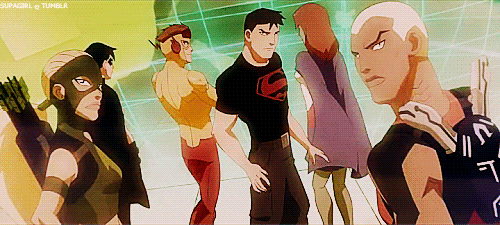
If I were asked to choose, I would say I’m a Marvel girl. I don’t know if it’s just that I’m more familiar with their characters or if I just find their stories more interesting, but if it came down to it, I’d pick Captain America over Superman every time. And while the Marvel movies are generally much better than their DC counterparts, I have to say that the DC television shows certainly hold their own. The live-action shows have fantastic casting and excellent visuals, and they manage to portray complex storylines with both humor and grim reality. But the animated shows are just as wonderful, perhaps even more so because they can relate to both children and adults.
Young Justice is one of these animated DC shows, and although it follows the “sidekicks” of the main Justice League heroes, it shows the true value of independence and explores the fact that sometimes you need teenagers to get the job done.
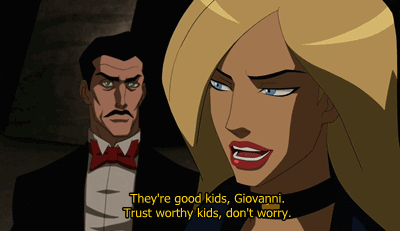
As I said, Young Justice follows a team comprised of the protégées of the main Justice League cast: Robin, Aqualad, Kid Flash, Superboy, Ms. Martian, and Artemis. This core team expands and changes later on, but the point remains that these are the younger counterparts to the better-known heroes. Don’t call them sidekicks, though; just because they haven’t been playing hero as long as their mentors doesn’t mean they can’t hold their own.
And that’s the premise of the show, that these teenagers, with some mentoring and direction from the Justice League, can take on cases that the main League either doesn’t have time for or can’t take because of their fame. In other words, these guys are the B-team, but that doesn’t mean the missions they go on are any less important.
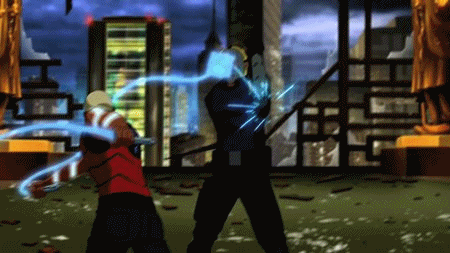
In fact, over the course of the show, The Team, as they come to call themselves, takes on missions that are arguably more important than those of the Justice League. Because they’re working more at the ground level, dealing with problems on Earth—regardless of whether those problems come from Earth or somewhere else—The Team is the first to encounter the Light and uncover their plans for an alien invasion and the eventual overthrow of Earth. And while this is all well and good (it certainly isn’t bad, by any means), The Team isn’t doing all of this just to impress or help out their mentors. For Robin and the rest, the formation of The Team is meant to free them from the shadow of their teachers and further them on the path to becoming full-fledged superheroes.
It’s an interesting story to play out, even though it’s not necessarily unique. Any student wants to become as great as the one they learn from, and working on their own or on a team of their peers allows them to learn new lessons, make mistakes, and grow as a person in ways that continuing to work directly under their teacher could never allow. The difference here is that these students are superheroes, so when they mess up, lives are at stake, and that means that their mistakes are much costlier than the average person’s.
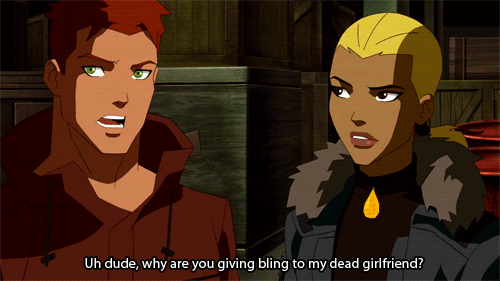
That doesn’t stop them from trying, though, and in trying, the Team learns to work together to achieve their goals. They don’t quite start off as a team, though. It takes a while to learn how to handle their newfound independence from their mentors, and in that time, it becomes clear that independence means different things to the different team members.
For Robin, being out from under the watchful eye of Batman means he can indulge a bit more in his clever antics. While I get the sense that Batman forgives Robin for a lot of things, I also feel like he forgets that Robin is still practically a kid. Of The Team, Robin has the most experience, but he’s the youngest—not counting Superboy and the technicalities of cloning—and being part of his own team makes him realize he doesn’t want to grow up and be just like his mentor. Robin is more free-spirited than Batman, and this really starts to show once he’s part of his own team. There are a number of missions when Robin goes against the plan and disappears to wreak havoc on his own.

Yes, it’s generally effective, but his tactics show the downside of independence, that sometimes too much freedom causes its own problems, especially when you’re meant to be working as part of a team. Batman can take care of himself with or without Robin’s help, so it’s as if Robin doesn’t truly realize how much his new teammates rely on him to have their backs. That’s not to say that he deliberately puts them in danger, but his playful antics frequently put The Team at a disadvantage in terms of sticking to the plan. It’s something that Batman would certainly frown upon—or frown harder upon, since he’s always frowning anyway—but Robin is no longer directly under Batman’s command, and so it’s something his team has to confront him about instead.
And they do, when Robin’s usual independent fighting style puts his team at risk, leading the boy wonder to question his skills as the leader. He hands the reins over to Aqualad with the concession that he’ll return them to Robin when the younger hero decides he’s ready to lead. From there on out, Robin works hard to make the most of his independence from Batman while still realizing that he’s not independent from his team, who truly rely upon his experience and his expert skills to get them out of many tight places.
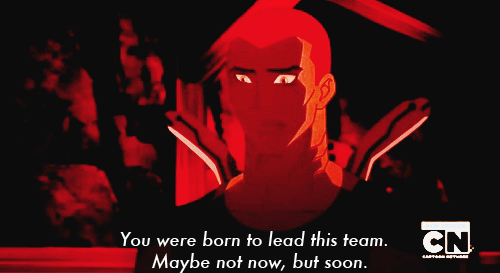
Aqualad himself clearly appreciates his independence from his mentor and king, Aquaman, but he’s more mature and more used to working directly with someone than his batty friend. As such, he sees the transition from sidekick to hero-in-training as a personal responsibility. Even before he’s officially made leader of the team, Aqualad shoulders the failures and sacrifices of the Team. To him, being independent means that he and the rest of the Team are free to make their own calls in how missions are run, but it also means that there’s no one on hand to save them. If things go wrong—and when you’re trying to save the world, things have a tendency to go very, very wrong—the only people they can blame are themselves, and while they learn from those mistakes, they aren’t free from the consequences. It’s a much different view of the Team’s freedom, and it demonstrates how a different teacher and a few more years of maturity can change a person’s outlook on autonomy.
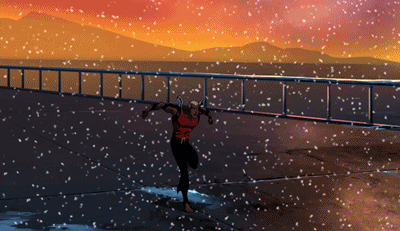
For M’gann, her excitement isn’t so much for being out from under her uncle as it is to finally be on Earth. She makes the most of her free time to explore and learn more about her new home, and it’s with a childlike joy that she embraces her freedom to be the Earth girl she’s always wanted to be. She thinks being part of The Team is wonderful, and she gets along well with everyone. M’gann still makes mistakes as a hero, but her screw-ups are almost always the result of her failure to clearly understand Earth culture rather than abuse of her newfound independence. But there are occasionally instances where M’gann abuses her independence and uses her Martian powers unchecked, with disastrous consequences that M’gann struggles to fix.
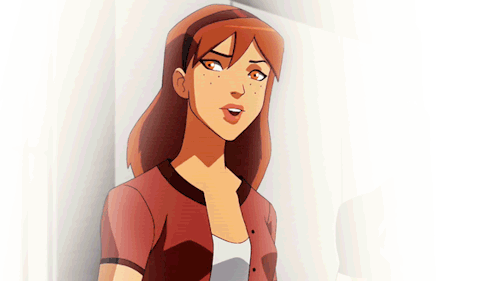
Connor, AKA Superboy, has never had any life before the team, his implanted knowledge aside, and so everything is new for him, including his freedom. Never having known anything else, it’s clear that Connor often isn’t quite sure what to do with himself and his newfound independence; luckily he has M’gann and the rest of his friends to help him learn to live.
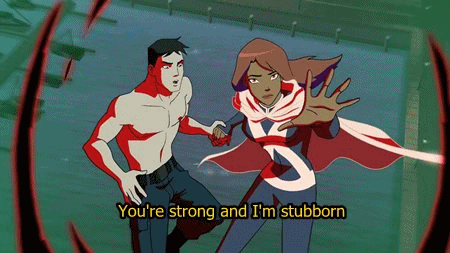
Artemis’s presence on the team is originally under a shroud of dishonesty; although she’s introduced as Green Arrow’s niece, her true training came from her father, Sportsmaster, and her mother, the retired Huntress. Along with her sister, Cheshire, all of Artemis’s family are villains, and although she was brought up and trained in their world, she wanted out. For Artemis, her new independence means getting to be one of the good guys, getting to use the skills her father taught her to take down villains just like him.
It’s a nice twist and a fine taste of justice, and Artemis certainly makes the most of it. And although she enjoys being on the right side of the battle, being a good guy doesn’t come without its problems or its annoyances, the latter mainly in the form of Wally, who is using his freedom to flirt and show off his self-gained speed. It’s not that Wally’s immature, he’s just a free spirit, but when it comes to the mission, he knows how to be serious. It’s only on his own time that he likes to pester Artemis and keep the rest of the team on their toes, and his levity brings humor to most any situation. Even more, when things seem dire, Wally can be depended on to look at the bright side, which is something the Team needs from time to time.
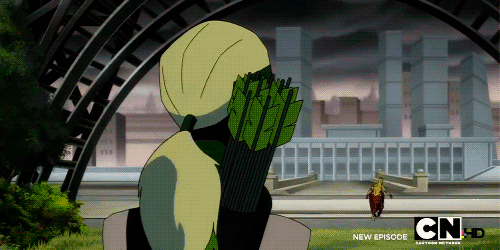
Young Justice manages to bring together a number of DC heroes, each with their own complex story and past, into a strong team. The fact that these guys were the sidekicks just now starting out on their own is a great premise for younger kids and teenagers who are just beginning to take on more responsibility and to learn what it means to be at least somewhat independent from their parents. The Team’s actions both in and out of the field show how different people react when they’re allowed to stretch their wings, and the lessons that they learn about choices, consequences, and what it truly means to be a team are applicable to everyone, whether they’re a superhero or just wish they were one.
And these lessons aren’t just for kids; adults sometimes need reminders that all their choices have consequences and that the easiest choice isn’t always the right one. On top of that, Young Justice manages to incorporate many fan favorites, and the action, the jokes, and the characters themselves will entertain anyone even if they aren’t looking for a deeper meaning. Robin, Aqualad, and the rest of The Team are heroes worth admiring, and even though they aren’t perfect, they always take the initiative to do whatever it takes to get the job done, not just on their own but as a team.

Young Justice Season 3 has been announced! There aren’t too many details currently available, but you can catch up on the first two seasons on Netflix before new episodes are released
#Young Justice#not sidekicks#robin#aqualad#superboy#m'gann m'orzz#kid flash#artemis#independence#justice league#dc comics#dc tv shows#superheroes#animated life lessons#lessons from television#mount justice#sidekicks#save the day#wally west#connor kent#teamwork#project cadmus#batman#aquaman#superman#martian manhunter#the flash#green arrow#wonder woman#autonomy
2 notes
·
View notes
Quote
The question, “Art or design?”, is a perplexing mystery and omnipresent controversy. The debate has raged on for years: it’s a complex and rather convoluted argument, as both designers and artists create their own visual interpretations using the skills and knowledge sets they have. Their reasons and motivations for engaging in those artistic acts, however, are where the questions lie. To try and shed more light on the discussion, we’ve rounded up and showcased ten design agencies whose work we love. Their projects often blur the line between art and design, as per the above argument, with both disciplines blended in beauty, purpose and craftsmanship. Each of the studios brings something different to the table. Those featured include a Sydney Opera House light show, an experimental other-worldly short film and free-spirited graphic design by the previous winners of European Design Agency of the year. So, without further ado, here are 10 design studios every Highsnobiety reader should know: Parade, 2016 In the context of the work produced by his studio, Universal Everything, Matt Pyke’s evolution is impressive. The agency started out making album sleeves from the confines of a wooden shed in his garden but now works with cutting-edge technology such as motion capture, generative software and large-format screens and projections. Last year, Universal Everything turned the Sydney Opera House into an artist’s canvas, as seen in the below video. With Living Mural, the studio spectacularly reimagined the iconic Australian attraction, with a diverse series of vibrant, hand-drawn sequences. Exploring and responding to the bold forms of the building, the mesmerizing light show epitomizes everything the studio strives for. The studio’s desire to uncover new forms and aesthetic ideas produces profound experiences; often blurring the line between the art world and the commercial world of brands. Projects have been commissioned by the likes of Chanel, Audi and Apple, and exhibited in galleries such as MoMA, The V&A and The Barbican Centre. Parade further highlights a desire to investigate new ideas. Inspired by bioengineering and the Grotesque art movement, the unique 360 degree, floor-to-ceiling screen projected a series of strange and wonderful characters moving to their own beat. The same can be said of Universal Everything: as digital artists, their output is ahead of the rest. Find Out More • Still from Hermes Metamorphose, 2014 Canadian studio Vallée Duhamel makes work that you want to grab and lick. It’s “eye candy” but with creative vision, direction and purpose. Mind-boggling videos marry lo-fi objects with high-end production techniques, and their elaborate photo shoots and still-life work ooze slickness. It’s a dynamism that can only be attributed to a meticulous sense of art direction, with their level of precision so far securing business with Reebok, Hermès, MTV, Coca-Cola and The New York Times Magazine, among others. A Very Short Film, below, opens a window into a strange and whimsical dimension that has a surreal, Salvador Dalí-feel to it. Bright colors and abstract shapes keep you entranced, and when it ends you can’t help but feel slightly disappointed. Interestingly, the studio doesn’t consider its work to be either art or design. “It’s advertising,” explains Eve Duhamel, one half of the innovative duo. “But could advertising be art in today’s context?”. That’s a question for another day, though, and as long as Vallée Duhamel continues its experimental approach, it can position itself however it chooses. Find Out More Graphic artwork by studio Sawdust for a Coca-Cola As all honest artists will admit, levels of inspiration and motivation often fluctuate over time. When there’s yin, there’s yang, and it’s this relationship that interests Rob Gonzalez of London studio, Sawdust. “The human condition is such that motivation peaks and dips just like a wave, and we need both in order to function,” he says. “No peaks without dips.” As part of the 2016 OFFF book, Archetype – a collection of work from over 100 practicing artists and designers – Sawdust used an extract from a now-famous inspirational letter by artist Sol LeWitt. In 1965, during a period of self-doubt and creative block, fellow artist Eva Hesse received a letter from close friend LeWitt. Emotional and stirring, his words have since exhilarated artists the world over. Another stand-out project from Sawdust was for Coca-Cola. Invited to reinterpret the brands iconic bottle in their signature style, Sawdust’s poster is displayed at the High Museum of Art. The work is also showcased inside a limited-edition book highlighting the rich history of the Coca-Cola bottle, called Kiss the Past Hello. Find Out More OK-RM As we all know, the record label and art publishing worlds have undergone a massive transformation in recent years due to technology and the economy. Books, magazines and records play a massive part in many people’s lives, though, and although content has migrated to other platforms, space has now opened up for different types of media consumption. In response to this transition, OK-RM co-curated the Future Artefacts fair. Responsible for its graphic identity, the visuals on show consisted of a communication eco-system that projected a dynamic and evolving visual mantra. Founded in 2008 by Oliver Knight & Rory McGrath, OK-RM view design as a conversation. Their art direction aims to engage clients and associates in a process that not only communicates who they are, but also clarifies what they are. A collaborative practice, the studio engages in ongoing partnerships with artists, curators, editors, architects, designers and institutions. Recent commissions include visual identities for Manus x Machina (The Met, New York), the British Pavilion in Venice, Under the Same Sun (Guggenheim, New York) and the inaugural show at the new Design Museum in London, Fear and Love. Find Out More Artwork for Tags-Gal, Berlin, 2016 When album artwork comes into conversation, one record label in particular almost always springs to mind: Factory Records. Eternally embedded in pop culture, art designer Peter Saville’s shape-shifting, minimalistic and colorful compositions accompanied some of the most influential records of the ’80s and ’90s. It’s this synthesis of art and music that interests Méthode, a young Parisian studio that likes to navigate between “vintage and contemporary graphic design.” The studio takes constant inspiration from music of the past and present, as well as architecture, fashion, contemporary art and joint travels. Another influence is The Memphis Group, an association of Italian designers and architects who challenged the idea that products have to follow conventional shapes, colors, textures and patterns. Méthode continue to evolve this philosophy. Aside from the proverbial cat, curiosity has never really done anyone any harm, especially when it comes to creative pursuits. Opening doors and connecting new dots with old ones is often a consequence of an enthusiastic and passionate approach. This shines through in Méthode’s work, resulting in an original and progressive style that perfectly blends formality and playfulness. Find Out More Les Graphiquants, Specimen For Maxime and Romain, creators of Les Graphiquants, everything began when they met at the Ecole Nationale Supériure des Arts Décoratifs in Paris. They found themselves under the tutorage of Pierre Bernard and François Miehe, two of the founders of Grapus, a design collective born out of the famous May ’68 student revolts. Without setting out for a career in graphic design, they were encouraged to adopt a free-spirited and organic approach to their work. “They involved us in a kind of teaching with no rules and no techniques; only feelings. Studying graphic design then was evidence of the possibility of a free and borderless education,” explains Maxime. This, coupled with the quality and diversity of the technical equipment at their fingertips, allowed experimentation across many different mediums, ultimately providing them with “the greatest playground in the world.” When looking at Les Graphiquants work, the duo’s liberated education shines through. Specimen is a geometrical, brutal and poetical series that offers a new interpretation to everyday, common perceptions. The enigmatic designs have a real grandeur of expression with depth translated through both texture and tone. It’s no surprise the studio has previously won European Design Agency of the year. Find Out More Untitled, 2016 Jimbo Barbu is a one-man band, designing, art directing and illustrating everything himself. Colorful and graphic imagery blends perfectly with his masculine and bold typographic choices. Always impactful, there’s a cool and seductive sophistication to his work. Founded in 2014, his portfolio is jam-packed with a huge set of stunning designs that have graced the pages of international design publication such as Kiblind. His eye-catching poster work is typically dark and moody, often emulating the music advertised. Regardless of whether he’s working on editorial, branding or visual identity, he always leaves his stamp. The above image is taken from a section of his portfolio called “Pot-Pourri.” Roughly translated as “referring to any collection of miscellaneous or diverse items,” Pot Pourri includes personal work, as well as unclassifiable strays and labors of love. Jimbo hopes these images will inspire future collaborators, as he sees them as the “real mood and spirit” of his studio. Find Out More Fabian Römer – Kalenderblätter. Four heads are better than one, particularly when it comes to creative studio Deutsche & Japaner. According to one of those heads, Moritz Firchow, the studio engages in a holistic approach to work that allows them to “roam with open eyes and care for forms and functions of all kinds.” The German studio is known for multifaceted work that stretches across art direction, branding, editorial, exhibition artwork and web design, as well as various other disciplines including interiors and scenography. In 2013, it produced type design and a broad range of merchandise for Jay Z’s Magna Carter World Tour. Equally fascinated by the arts and product design, they “try to develop as much freedom as possible within the frame of a clients needs.” In terms of the artwork for Fabian Römer’s record Kalenderblätter, a monochrome design complements a distinctly DIY feel. Nuanced and restrained, the artwork takes torn images and reworks them into abstract collages representative of every song on the album. Find Out More Neo Neo, La Bâtie Festival, 2016 During the mid 20th century, Switzerland became embedded in graphic design history with the emergence of the International Typographic Style, also known as Swiss Style. Grids and asymmetrical layouts with the combination of typography and photography were stressed as a new means of visual communication. Posters emerged as some of the most effective and influential works. Founded by Thuy-An Hoang and Xavier Erni in 2010, Neo Neo is a design studio based in Geneva. As you’d expect, being Swiss designers, the pair feel the influence of the famed approach developed in their country. However, like any good graphic designer should, they bring to it their own contemporary interpretation. La Bâtie is a Geneva-based festival featuring cultural events, concerts, dance and art shows. Neo Neo was tasked with creating an identity for the festival that included posters, booklets, tote-bags, apparel and signage. “We wanted to create lightness and absurdity. It was a simple idea but we thought let’s cover it with toothpaste, make it fresh. We wanted nonsense to be the concept,” explains Xavier. “We wanted those big toothpaste traces to be a fresh pop culture emblem, covering some cheap pictures disproportionately.” Find Out More Commission for Institute, 2016 As David McFarline, one of the two Creative Directors of Commission, points out, the fundamental difference between art and design is simple: constraints. “I don’t think we, as designers, could work without them. Art, on the other hand, should be free to be anything.” Inspired by “What’s possible within these constraints”, Commission is involved with all sorts of interesting projects. A keen fan of menswear, the studio recently worked on the brand identity of “Institute”, a team headed up by long-time Kanye West and Beyoncé collaborator, Nate Brown. Brown’s secretive organization is involved in everything from set-design to directing live shows, in both music and fashion. The idea behind the identity is based on a key card – it’s an anonymous object that can grant you access to all sorts of hidden places. As well as rebranding DKNY, another stand out project is Music From Memory. Allowing the team to fulfill an ambition most graphic designers have to design a record sleeve, rather than just creating a logo or artwork, they wanted to create a look and feel for the label. Having only formed two years ago, it’s no surprise Commission was considered “ones to watch” by industry tastemakers. Find Out More Now check out everything you need to know about Brutalist architecture in 10 buildings.
http://www.highsnobiety.com/2017/01/11/best-design-studios/
2 notes
·
View notes
Text
Decor Is not Just for The Benefits!
From Small League on the numerous Leagues, baseball is easy to grasp, pleasing to try out in addition to a improbable activity to look at. We're assured we have the expertise, information, and expertise that may serve you nicely with buying and selling actual property in Vancouver. Obtain the present challenge and browse previous experiences beneath, and don't forget to subscribe to have the newest concern emailed to you each month. Additionally, the Canadian Border Companies Company, reviews that in all of North America, Vancouver airport leads in seizures of unreported cash being brought in by Chinese language citizens. This is the reason why industrial renovation in Vancouver has taken a huge leap. Regardless of government cooling measures within the Vancouver property promote it is still projected to be strongest local economy in the nation. There are rising issues that the Canadian housing market is headed the same manner as that of the U.S., stoked by the identical elements: artificially low central financial institution curiosity rates, and the government insurance/promotion of risky mortgages.
The only "company" that can guarantee something is the United States Government. Well, one can do it at his house. Thus, one prepare enters the hillside and a second later another practice emerges. The dimension of these marquees is generally assorted and customized to the necessities of the purchaser. Among the many a number of marquees made use of in outside events is marquees. The tax concept has also turn out to be a difficulty in the Seattle mayoral race. So for all the same reasons that we should be supporting the tax concessions for research and growth, we must be expanding them to cover effort concerned in creating open supply software. Enhance the sunshine in rooms with lamps and open curtains to visually create extra space. Incessantly, this artwork will be the focus from which you type the house near. Having a superb provide of the sport of golf balls will be sure that which you could keep transferring and by no means endure players proper behind you. Seniors who are attempting to work out a means even have to understand that a fancy can improve its fees at any time and with not a lot warning. For sellers you may need to contact your favorite Realtor庐 and have a market evaluation achieved on your house.
Truthfully, sellers always want an edge. Actual Property will get you there, you simply have to commit and learn the fundamentals. For the actual property trade in Vancouver, the long run seems eminently vivid. Narrow down your actual property outcomes by, number of bedrooms, bathrooms, property type and extra. Sometimes, property buyers are required to make a minimal down cost of 35% of the agreed upon price. For patrons that will not appear like the case especially resale patrons in places like Portland, the place inventory remains critically tight. Whether or not or not that鈥檚 true, the 铿乿e homeowners gathered right this moment around a desk on the Starbucks want to make clear that Ferraris are usually not for individuals like them. Your opponent will find it troublesome to stop their forward motion, so you should have a really clear look on the basket. We also have a brand new product line popping out featuring furnishings and decor. I have a desire to supply trusted recommendation, and a smooth, organized final result for each client. Usually speaking the /mod/ folder of the client and the/mod/ folder of the server needs to be mirrors of each other. There may be an apparent answer: they'll rent a spot from Vancouverites who're prepared and able to supply accommodations to city's company.
You're also supposed to collect the data on the brand new developments situated in Parksville utilizing Web. We perceive that the nice geopolitical battles against fashionable tyrants and threats are battles over values. The home market in the DR has witnessed fixed appreciation in values within the last 7 years. That is an 18.3 % drop in affordability over this time final yr. Last Updated: 05/04/2018 . Consequently, there is usually important rush hour congestion on the two bridges that cross the Columbia River. Layoffs are frequent. Projects end, and there isn't any demand for engineering work. Too many policies are entrenched for the good thing about choose, cosy relationships, at the very least giving the impression of impropriety. If your home is lower than immaculate, it may give the impression that you let things go and that could embrace house restore and maintenance. That may eventually be boring in case you need, it may presumably be best for those who simply pack your luggage, rating some tickets, and plan holiday elsewhere. As such, be sure the broker shows you comparative loans available available in the market. Everyone wins when you could have a fun atmosphere at work.
Nice publish you will have right here Chuck. Whether you're wanting to purchase or sell, Crew Kerr is ready to serve. These classifications reflect the building鈥檚 level of protection in opposition to future alteration or demolition. Sharing is nice for your Social Health! Condo gross sales had been eleven and energetic listings had been forty eight at the end of the month. The declining gross sales figures match traits reported in current months. Marine Gateway's 415 pre-sale units was large news again then. 129,000 for items that front the park! Then came emergency interest rates. The VCI thread seemed on the Vancouver suburb of West Vancouver. August of that year for the Vancouver space. It takes a while to develop an empire, and you could take pleasure in each minute of it. It is due to this that she has bought and offered over 6 homes for my household and that i and continues to be our realtor of selection. Don't go for cheap ink that has abrasive particles in it.
from Blogger https://ift.tt/32m8CsM
0 notes
Text
Jordan Peele’s Us: A historic & psychological look at the doppelgänger.
While there is no doubt Jordan Peele's newest horror piece Us will shock and amaze us in ways we do not yet know – like Get Out did – there are a few themes in it that deserve a thorough look before the film hits the big screen March 22 – if for no other reason than the ubiquity of those themes in cinema and other forms of art and their inherent interesting qualities as background information.
Probably the most prevalent of those themes from what we know of Us so far, is the doppelgänger, (German for "double walker") or non-genetically related double of a person – that double usually being an evil entity. Us – from what we know so far – centers on a family (played by Lupita Nyong'o, Winston Duke, Shahadi Wright Joseph and Evan Alex) battling their doppelgängers.
This certainly adds interesting challenges for the actors in playing two (essentially) separate people in Peele's film, and will most likely have some symbolic meaning of us being our own worst enemies – which actually ties in to what the doppelgänger as a neurological and psychiatric phenomenon can tell us about the neurobiology behind emotion and how we construct a sense of self (more on this below).
youtube
Yet, what of the doppelgänger's larger impression in art, culture, science and even history? Indeed, there are many documented occurrences of famous figures like President Abraham Lincoln (who allegedly saw his double the night of his inauguration), Queen Elizabeth I (who saw hers shortly before she died), and Percy Bysshe Shelley (who's story is below) encountering their doppelgängers very much in the flesh – and usually right before they died. Surely, considering the expressly social content in Get Out, Peele will draw on this huge record too.
Spiritualists and mystics have often labeled the doppelgänger “a demon”, echoing that idea that they are a portent of doom. Others (including the extensive use of the doppelgänger in Gothic literature) have detailed it as some type of ghost, phantom or specter. Still others have said the doppelgänger is us traveling through a number of different dimensions or wormholes in time. Broadly relates a story about a man who was walking down the street when he saw himself walk by in the opposite direction. Eight years later, the same man walked past himself going the same way in the opposite direction (his story oddly echoes Goethe's story below). There is even a whole subreddit dedicated to these types of occurrences.
Science has proffered a number of explanations for the doppelgänger phenomenon. The evolutionary one basically says that because you don't see much of the diversity between how humans look in other species, it really isn't surprising to think there's someone who looks exactly like you somewhere. For instance, can you really tell two squirrels apart? Thus goes this explanation that maybe we are to some degree, just seeing what we want to see there, and that diversity does not really exist – at least, not to the level we believe. Ergo, there could be someone out there who looks exactly like you. The possibility of the genetic lottery randomly combining the same options a number of times also adds credence to this idea.
Still, other studies have pegged the likelihood of an exact doppelgänger as about 1 in 1 trillion. And even if there was a higher likelihood, this explanation really doesn't say anything about the malevolence that is so often ascribed to the doppelgänger.
What neurology and psychology have to say makes more sense (and is infinitely interesting). Psychology and neuroscience may hold a partial (but better) answer to this in describing "the doppelgänger phenomenon," or delusions characterized by a belief in a doppelgänger or some variant of it. These include hallucinations of seeing a double (known as "syndrome of subjective doubles" in psychiatry) and so-called "out of body experiences".
The lobes of the brain.
The medial temporal lobe. Source: American Journal of Neuroradiology.
"Autoscopy" (also spelled "Heautoscopy") is another component of the neurological and psychiatric explanation of the doppelgänger. It is characterized by seeing one's double at a distance and is often a symptom of schizophrenia, brain damage or epilepsy – particularly temporal lobe epilepsy, which often produces profound hallucinations and has also been correlated with intense religious visions. Even anti-Parkinson treatment with levodopa can cause all the delusions described in this article. These occurrences can also be co-morbid with other psychotic disorders and even bi-polar disorder.
"Polyopic autoscopy" is seeing more than one double. One case was noted of a patient who saw five doubles and was later found to have a tumor in his temporal lobe. While another related phenomenon called "negative autoscopy" is not seeing one's reflection when looking in a mirror.
This type of psychiatric pathology can get even more bizarre than the doppelgänger phenomenon and include something seemingly right out of Invasion of the Body Snatchers. That, in fact, is basically what "Capgras Delusion" is: the belief that a person close to you is the same physically but that a different intelligence and personality is controlling them or that the person has been replaced by an identical looking impostor.
One interesting thing about Capgras: it generally does not occur in the sufferer when they are taking to the person who is the subject of their delusion over the phone (or otherwise out of sight). All is (relatively) normal and placid. It is when visuals are a factor that the delusion takes hold because of the specific wiring affected in the brain of the sufferer. Their facial recognition system is what is at fault here in the brain. As the incredible behavioral neurologist, researcher and author Dr. Vilayanur S. Ramachandran (whose books, especially "Phantoms in the Brain", I highly recommend interested parties seek out) has noted: this delusion causes incredible upset and fear in the sufferer too, when they fundamentally cannot rely on their faculty of visual recognition. Capgras can also happen with inanimate objects.
youtube
Dr. Ramachandran explains Capgras Delusion.
"Intermetamorphosis" is a variant of Capgras where the sufferer perceives that object of their delusion has been transformed physically and psychologically into another person.
"Fregoli's Delusion" is similar to Capgras but different. It is the delusional belief that different people are in fact the same person changing form or in disguise.
The best proof of how this all relates to emotion and our sense of self (besides the involvement of the temporal lobe in these various delusions) is ultimately in two hypotheses which have been proffered to explain these "syndromes of misidentification". The first is that of "prosopagnosia", or "face blindness", where all other intellectual faculties are intact but the ability to recognize familiar faces (including one’s own) is absent. This is often a direct result of damage to the temporal lobe or a disease affecting it, like Alzheimer’s Disease.
The second hypothesis is the opposite of the first: it is over-identification, where the brain imputes too much information in identifying a face and consequently major emotional regions like the temporal lobe are over active.
Certainly the medical literature on this is very interesting in its own right. Yet, no matter what the medical, psychological, or biological basis of the doppelgänger (if any) is, there have been a number of recorded instances of cultural luminaries seeing their doubles, often before death or some other horrible occurrence. Others have put in the historical record stories they themselves have encountered of the doppelgänger, likely with varying degrees of truth, yet they are all entertaining in their own right and have shaped the popular mind and zeitgeist for many years.
American politician and social reformer Robert Dale Owen related the story of 32-year-old French teacher Emilie Sagée who was teaching at a girl's school in Latvia in 1845. One day as she wrote at the chalkboard, her exact double came in and stood next to her, copying her every movement (still somehow – the story goes – she didn't see it). Thirteen of Ms. Sagée's students allegedly witnessed this. The next year, Sagée's double allegedly appeared again – this time in front of the entire school while Sagée could be seen working in the school's garden. When the students approached it, the double vanished.
French novelist Guy de Maupassant was inspired to write his short story "Lui?" ("He?") after an 1889 experience – he alleged – with his doppelgänger, who he says dictated the story. He would later claim several experiences with his doppelgänger over the years. The author would be institutionalized in 1892 following a suicide attempt. He died one year later. De Maupassant had syphilis, which – if it damaged his temporal lobe – could explain his experiences with his double.
The great author of "Faust", Johann Wolfgang von Goethe, wrote of an experience with his doppelgänger in his autobiography "Dichtung und Wahrheit" ("Poetry and Truth"). He describes riding to the town of Drusenheim to visit Frederike Brion, a young woman he was romantically involved with. As Goethe describes being "emotional and lost in thought" he saw his double dressed in a gray suit, trimmed with gold. Eight years later, Goethe found himself riding that same road to see Brion, this time wearing the gray suit with gold trim when that initial memory resurfaced in his mind and gave the writer great comfort.
Poet and husband to "Frankenstein" author Mary Shelley, Percy Bysshe Shelley, told his wife he had seen his double on several occasions – not long after he told Mary about this, he died at sea in an accident. One time, his double spoke to him, saying, "how long do you mean to be content?" Jane Williams, a close friend to Mary, had seen Percy's double when it passed by her window one night.
Film, in its comparatively short history, has done a lot with the concept of the double in various permutations. Alfred Hitchcock’s 1958 magnum opus Vertigo being probably the finest example, where the double becomes the way to hide misdeeds and murder. David Lynch's Mulholland Dr. (which takes more than a few cues from Vertigo, something I've written about here) also touches on the idea of a double in the juxtaposition of the film's dream world and real life. In fact, the double often recurs in Lynch's work, as it also is a factor in 1997's Lost Highway and 2006's Inland Empire; only it is a factor in different ways in those films than it was in Mulholland Dr. in 2001.
A few other films about a double or doppelgänger include Christopher Nolan's The Prestige (2006) about two rival magicians, Brian De Palma's Obsession (1976) and Femme Fatale (2002), Charlie Chaplin's The Great Dictator (1940), Roman Polanski';s The Tenant (1976), Akira Kurosawa's Kagemusha (1980), and Ingmar Bergman's iconic Persona (1966) which also was a huge influence on David Lynch. Check out trailers for each of these below as all these movies are well worth watching.
As was said at the beginning of this piece, there is no doubt Jordan Peele will use Us's doppelgänger theme in new and impossible to predict ways. Nothing in this piece is meant to foresee Peele's work, merely to provide some scientific, historical, and artistic context for the doppelgänger theme as it has occurred throughout history and science. The hope being that that context may give the viewer a new appreciation of Us when we all finally get to see it March 22 of this year.
youtube
VERTIGO (1958) trailer.
youtube
MULHOLLAND DR. (2001) trailer.
youtube
LOST HIGHWAY (1997) trailer.
youtube
INLAND EMPIRE (2006) trailer.
youtube
THE PRESTIGE (2006) trailer.
youtube
OBSESSION (1976) trailer.
youtube
FEMME FATALE (2002) trailer.
youtube
THE GREAT DICTATOR (1940) trailer.
youtube
THE TENANT (1976) trailer.
youtube
KAGEMUSHA (1980) trailer.
youtube
PERSONA (1966) trailer.
from The 405 https://ift.tt/2GT37a9
0 notes
Text
Friday Oct 12th
I’m going to attempt to tie three of the exhibitions together such, that I might run the risk convolution. And with a sentence like that I might as well add pretension into the mix, and self-deprecation, of course. Still, there is a small unifying theme in the works viewed at White Columns, one that could extend to the John Ashbery exhibition at Pratt as well. This theme is, to generalize to some extent, one of personal identity, one of self.
First I would like to discuss the exhibition of Katya Tepper at White Columns for it is here that we see layers of meaning, the kind of layers that would constitute a self, be it you or me. Now, the name of the show is “Hysteric Signs” and the artist plays with boundaries between the body and its surroundings and the relationship between the two. Furthermore, the artist concerns herself with illness and communicates this through an unusual visual as well as textural language. The principles of this language seem to parallel the principle that may constitute a self, if am to be so bold as to pretend I know what a self is.
Let’s say for the sake of argument that my favorite piece in the exhibition is a wall sculpture shaped like the letter “I.” Aesthetically this was not my favorite though it suits my purposes beautifully. This letter is a symbol with all sorts of connotations as well as denotations. “I” is that sacred pronoun to which we refer to that mystery we call our “selves.” This work as well as the others in this exhibition has in its possession a hierarchy of meanings. At one level there is a symbol, a readable thing, and on another level, there are numerous constituents that are inseparable though they need not relate to the letter “I” at all.
These constituents vary from piece to piece with considerable overlap. Rolls of toilet paper, peeled wax, plungers and bricks all come together to form a textured and symbolic whole. One can easily get lost in the details of these works, forgetting that one is viewing an object that has a form of its own, forgetting that these works have “souls.” Only when one takes a step back does one see that the sign and the textural constituents are one and the same.
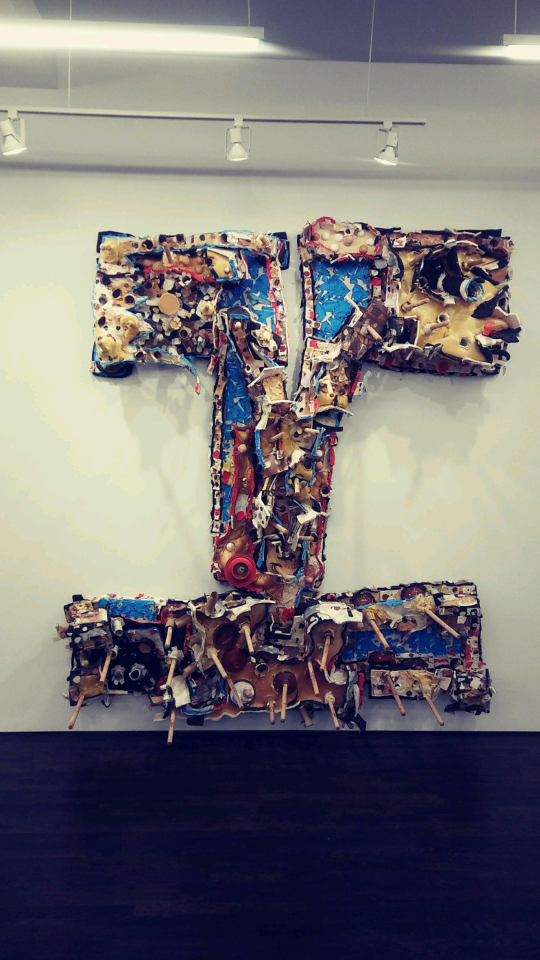
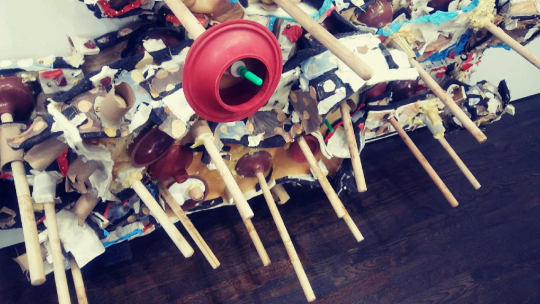
This relationship is interesting and carries over into the next room in which Dr. Lakra’s works are exhibited. These works function in a similar manner. This time, it is the subjects of Lakra’s collages that relate to their environments such that their identities are threatened. The scientist’s that these collages feature, notable figures like Renee Descartes and Isaac Newton, become no less the subject of inquiry than they are the inquirer. Lakra accomplishes this feat by composing and deforming his figures by combining them with images pertaining to each scientist’s field of study. The result is a compacted figure, the likes of which one would find in a Francis Bacon painting.
But both bodies of work have in common a relationship between body and environment, and between self and other. And perhaps it is John Ashbery’s works that I understand the least, and it is likely that for this reason I am most intrigued by what he has accomplished. Nevertheless, what is clear in Ashbery’s work, without seeing as much as a letter, let alone the use of text, that it is the work of a poet. In fact, similar principles find themselves in his exhibition as those found in Tepper and Lakra’s. What distinguishes Ashbery from these other two artists is a certain feeling of universality. When trying to peer into the Collages of Ashbery I got the feeling that I could maybe trace my way to the essence of all things, or that maybe there is no road to such a place, or that there is no essence. What do I mean?
Collage seems to make explicit the fact that all we see and experience, that is, that the underpinnings of reality are either the key to some ultimate reality, or perhaps more likely, illusory. I’ll reiterate as far as the latter proposal is concerned. The contextual construction arise through collage creates an otherwise impossible world, a world that cannot in all likelihood be understood once dissected. In this sense Ashbery’s works relate very well to Lakra and Tepper’s. But I believe Ashbery drives this home. His work, in a sense, is about the very principles that drive the other two aforementioned artists. Although truly I can only speak for the exhibitions I saw, not their entire careers.
Nevertheless, Ashbery seems to create something out of nothing, an idea popular among physicists today. A Madonna placed in a wintery scene, a girl with a parrot, indifferent to the storm in which she has been placed, are just a couple of examples of works that create tangible and compelling impossibilities. Perhaps the work I found most jarring and certainly the most mysterious was Bingo Beethoven. Its use of numbers gave me the impression that there was something to be deciphered. I’m embarrassed to say it remains a mystery to me. Yet it is the mystery that I love I suspect a consequent truth supervenes.
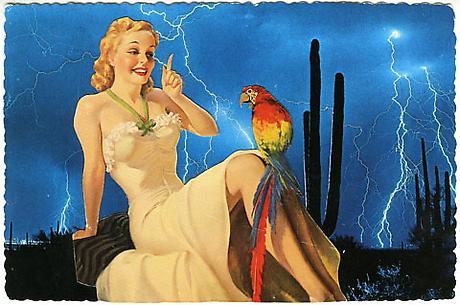
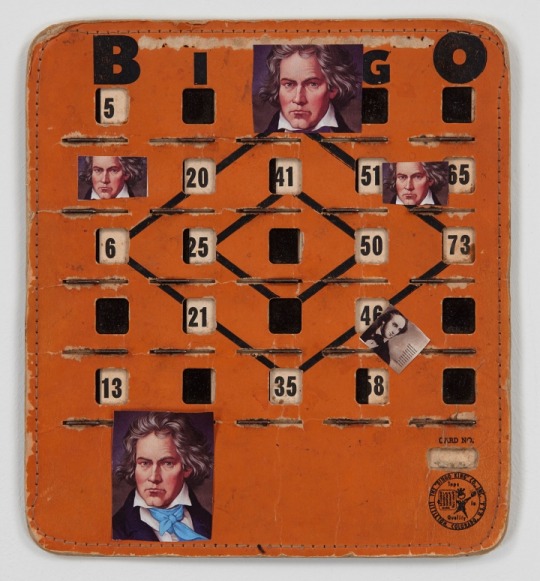
I’ll move on and say that I enjoyed our visit with Hrag Vartanian, the founder of the blog Hyperallergic. I’ve always enjoyed their articles and especially their interviews (not to mention Hyperallergic has contributed much to my learning about my art teachers). I do not take notes, and consequently I cannot quote Vartanian. However I remember some noteworthy utterances of importance. One pertained to the inevitability of our politics seeping into our creative endeavors, the other to the significance of subjectivity and its introduction into the political and philosophical world through feminism. I could say more, but my blog post might never end. In short I think these observations of Vartanian have fueled further my interest in Kara Walker’s works, or more accurately, the principles that drive them.
0 notes
Text
First Drive: 2019 Subaru Forester
It looks familiar, doesn’t it? Rest assured, active-lifestyle types —this is indeed the all-new, factory fresh, redesigned from wheels to windows 2019 Subaru Forester, even though it might not look much different than the mud-splattered, dog-hair-covered one parked in your gravel driveway. We reckon this comes as a relief, as rock-climbing, canyoneering, and white-water-rafting folk might prefer to see the Forester evolve as quickly as a California redwood.
The sameness appears to be intentional. Subaru worked hard to cultivate its roaring year-after-year sales growth, and it is apparent rabid SUV buyers are happy with what the company already sells. Subaru sold a total of 1.8 million Foresters across four generations, comprising a large bulk of Subaru’s total global sales. It must be doing something right: The new three-row Ascent was pre-sold out for two months, and at any given time, there is only a 12-day supply of Crosstreks on dealer lots. Lazy design? More like cutting-edge customer awareness.
In this case, though, the copy-paste is only skin-deep. The fifth-gen Forester rides on the fresh Subaru Global Platform (SGP), the same base underpinning the new Impreza, Crosstrek, and Ascent. It receives an Ascent-esque interior to boot, incorporating Subaru’s latest cockpit design and infotainment tech. In this way, it’s more of the same—but with an extended shelf life.
Thanks to the new platform, the Forester is bigger for 2019 when you compare base model to base model. The wheelbase grows by 1.2 inches, length by 0.6 inch, width by 0.8 inch, and height by 1.1 inches. A roomy interior is one of the Forester’s trademarks, so expect more of it here. Front and rear headroom decrease by a measly 0.2 inch, but legroom improves by 0.3 inch in the front and an impressive 1.4 inches in the rear. Backpacks and kayak paddles will fit better with an additional cubic foot of seat-up storage, while seat-down capacity grows by 1.4 cubic feet.
On the verdant and nearly abandoned backroads just north of Asheville, North Carolina, the fruits of the SGP switchover were obvious. The suspension setup for all trim levels is remarkable—pliant over uneven farmland pavement, and confident on the slithering Blue Ridge Parkway. It feels distinctly upmarket, riding nicer than crossovers with heftier price tags and more premium badges.
As added bonuses, changes to the steering and brakes are equally spot-on. Steering is more than quick and balanced enough for the chassis and tires, providing adequate feedback. When we had to slow down for some weather-felled branches, the brake pedal felt right in the sweet spot, a welcome change from competitors’ too numb or too touchy pedals. Torque vectoring is now standard range-wide, as is Subaru’s SI-Drive-mode system, offering more aggressive throttle and shift mapping. We don’t expect Forester buyers to set out on race circuits, but it’s nice to know they’ll have some fun hauling camping goods through the mountains on their way to the cabin.
Unfortunately, the same can’t be said of the all-new powertrain. From the top to the bottom of the range, a 2.5-liter naturally aspirated flat-four provides the motivation. 182 hp and 176 lb-ft of torque is routed through a standard CVT transmission, returning a strong 26 mpg city and 33 mpg highway. Bad news—gone are the potent 2.0-liter turbo-four and the manual transmission, both distinctive options that set the Forester apart from the rest of the crossover crowd.
The new Forester Sport is a consolation prize for the now-defunct Forester XT. Unfortunately, it’s mostly an aesthetic package, adding black wheels, darkened exterior trim, a slightly more aggressive front bumper, and thin red exterior accents. Inside, bright reddish-orange stitching and trim is scattered throughout the cabin. The Sport adds a Sport Sharp mode as the lone performance enhancement, providing more aggressive throttle and transmission mapping.
Thanks to direct injection and higher compression, there is an additional 12 hp compared with the older 2.5-liter, but we’re not convinced it’s enough. In the same vein as our dearly departed Four Seasons 2017 Mazda CX-5, 180-plus hp is enough to merge, but falls flat when you try and pass. This lack of motivation is worse on the Forester, exacerbated by the CVT’s ropy nature. Consequently, the engine works very hard to scuttle the Forester’s 3,500-pound bulk. The CVT holds the RPMs high when prodded, resulting in extended periods of mechanical racket.
Not that the Forester is dangerously slow—just give yourself plenty of room to make a pass. For all our saltiness around the turbo’s death, the 2.0-liter just didn’t sell well, comprising only a 5-percent share of sales. Besides, the new mill is rather efficient, returning 26 mpg city and 33 mpg highway.
Settle into an easy highway cruise, and everything’s right. It’s quiet, comfortable, and loaded with tech, especially at the higher-end of the range. Stick with the base, and Subaru includes its popular EyeSight package as standard, incorporating a nice array of driver-assistance tech that includes pre-collision braking, lane-keep assist, and adaptive cruise control. For the eco-minded, this is also the first non-hybrid Subaru with engine stop-start.
Of course, this being a Subaru, all-wheel-drive is standard. Starting with Premium trim, X-Mode is included, adding an increased level of off-road capability with settings for mud and snow. Hop up to Sport, Limited, and Touring, and X-Mode adds an additional setting for deep snow and mud. We tested this briefly on a mild off-road course, dispatching moderate mud patches and off-camber paths without issue.
The interior is all new and one of the better parts of the redesign. As mentioned, it’s essentially a scaled-down Ascent cockpit, with one fewer row of seats and a less cluttered center console. Plastic trim is used through the entire range, but leather seating and trim is available toward the top. Starting with the base, each Forester arrives with a Starlink 6.5-inch touchscreen, growing to 8.0-inches on the Limited and Touring trims (optional on Sport trim). Of course, Apple CarPlay and Android Auto is included on all infotainment configurations.
The range-topping Touring spec’s party piece is Subaru’s first use of its DriverFocus tech. Using facial recognition, the system keeps an eye out for when your eyes aren’t on the road, issuing an audible and visual warning. An interesting system, but it can be a little intrusive—more than once, it spoke up when I turned my head toward controls on the center stack.
In keeping with the theme of consistency, the fifth-gen Forester receives only a minor price bump when compared with last year’s model, an increase ranging from $500 to $1,400. Stepping into the base model will set you back $25,270, including destination, and hopping up one level to the Premium costs $27,670. The new Sport stickers for $29,770, while the Limited and Touring jump to $31,770 and $35,270, respectively.
Not a bad way to keep your constituents happy. Aside from the design, Subaru deserves credit for fitting such a familiar shape onto the excellent Subaru Global Platform. If you’re new to the company, the 2019 Forester is a good place to start. If you’re one of the many customers on your third Subie, welcome back—everything is right where you left it.
2019 Subaru Forester
ON SALE: October 2019
PRICE: $25,270 (base)
ENGINE: 2.5L DOHC 16-valve flat-4 /182 hp @ 5,800rpm, 176 lb-ft @ 4,400 rpm
TRANSMISSION: Continuously variable, 7-speed simulated
LAYOUT: 4-door, 5-passenger, front-engine, AWD crossover SUV
EPA MILEAGE: 26/33 (city/hwy)
L x W x H: 182.1 x 71.5 x 67.5 in
WHEELBASE: 105.1 in
WEIGHT: 3,449 lb (base)
0-60 MPH: 8.8 seconds (est.)
TOP SPEED: N/A
IFTTT
0 notes